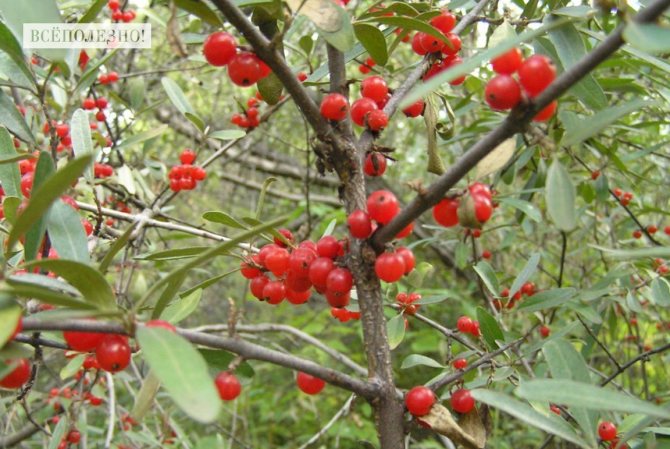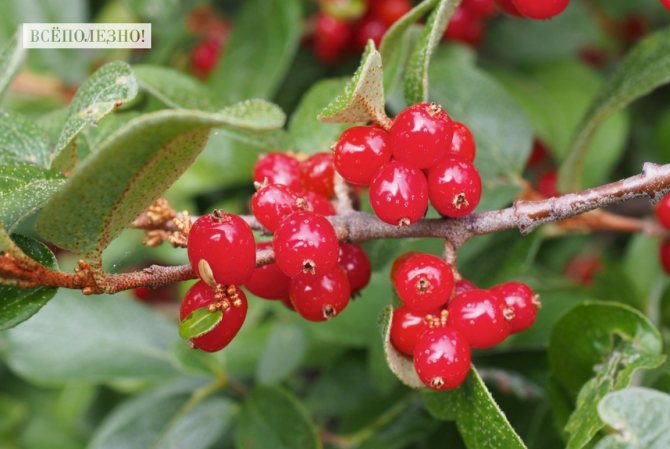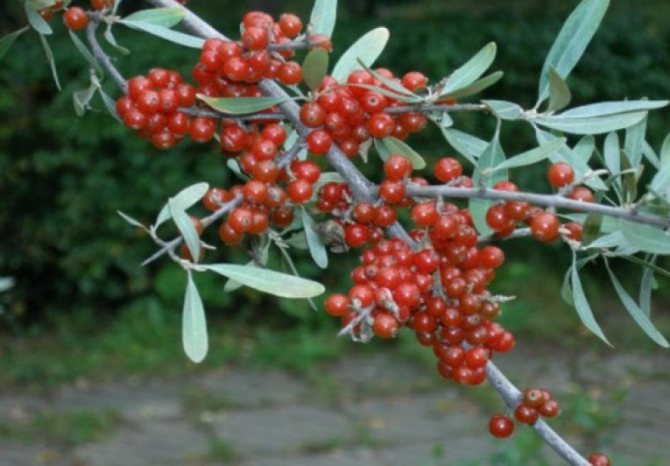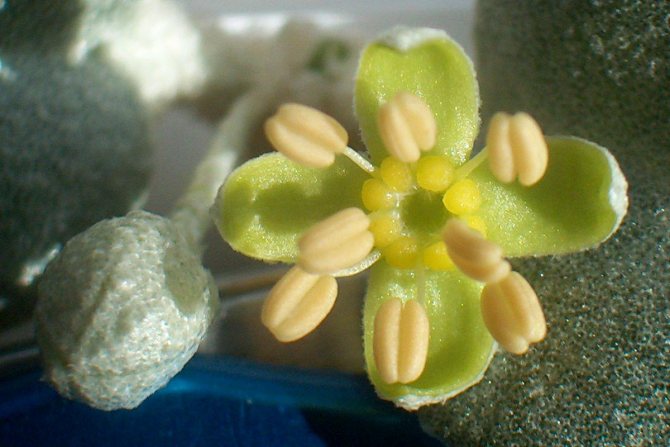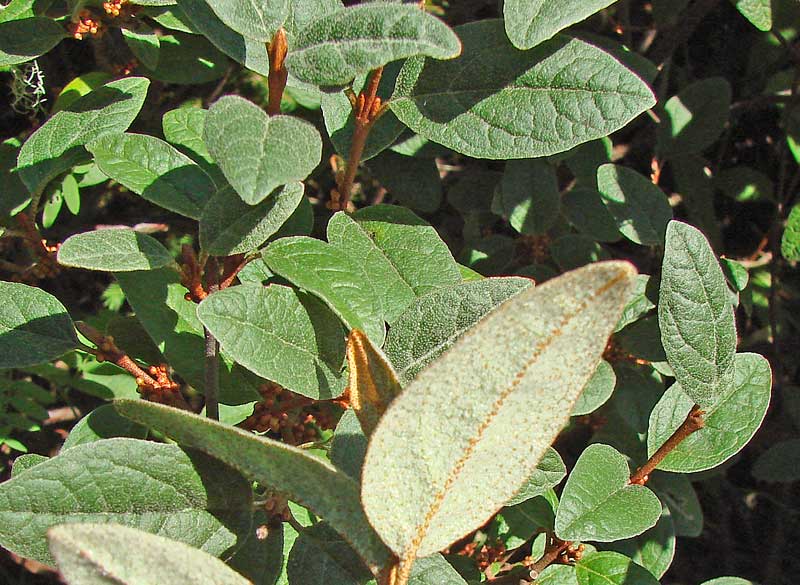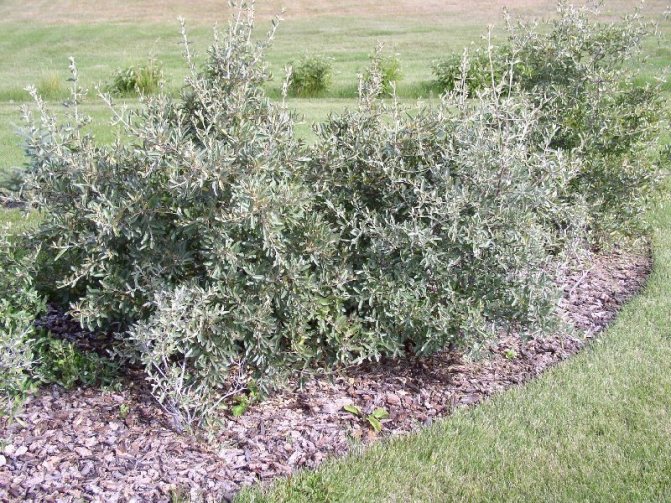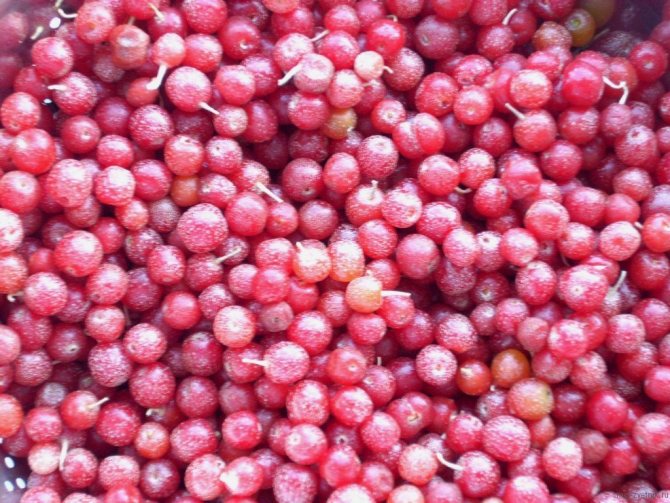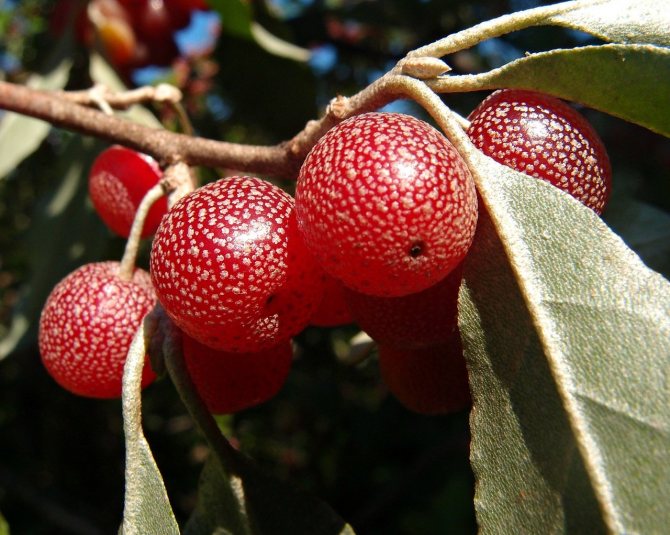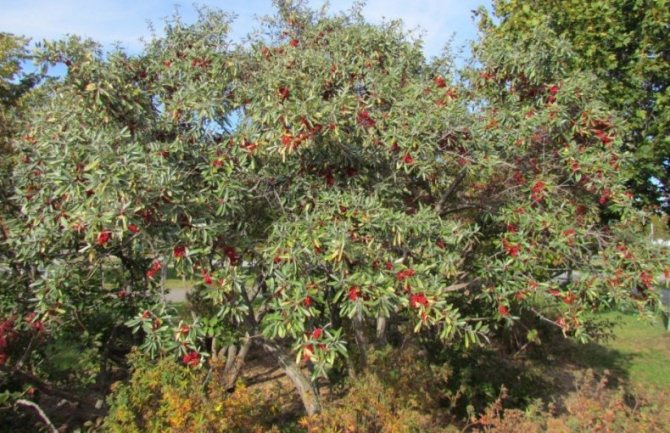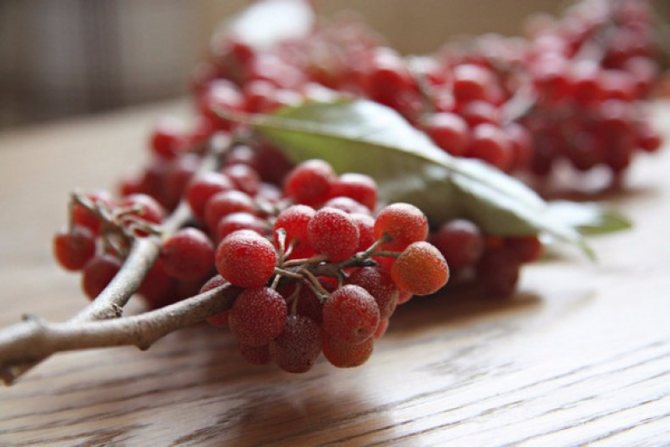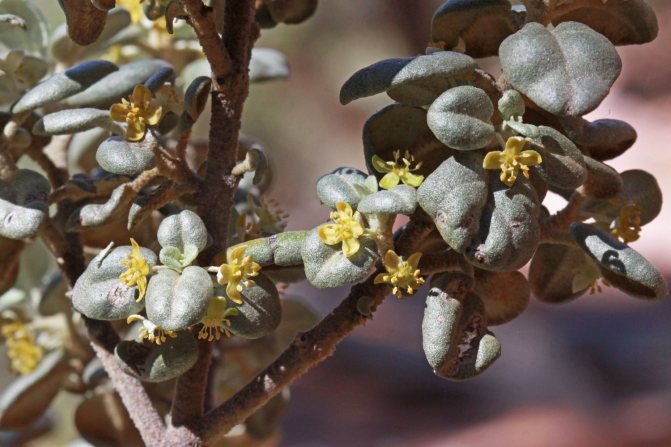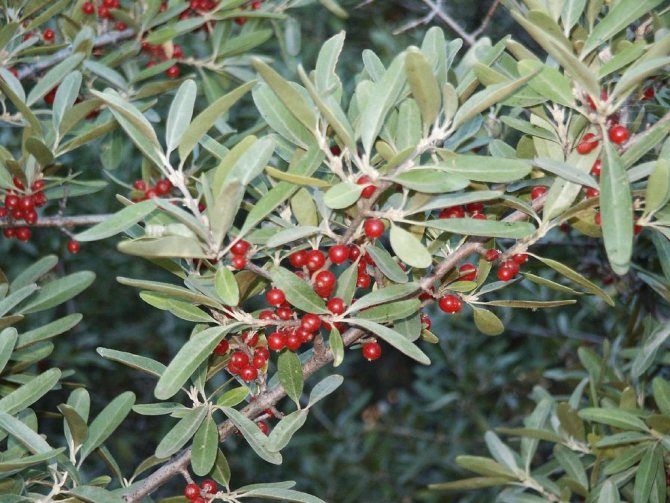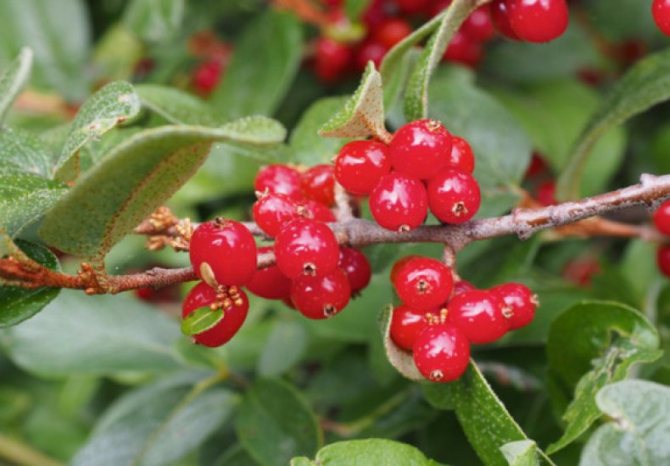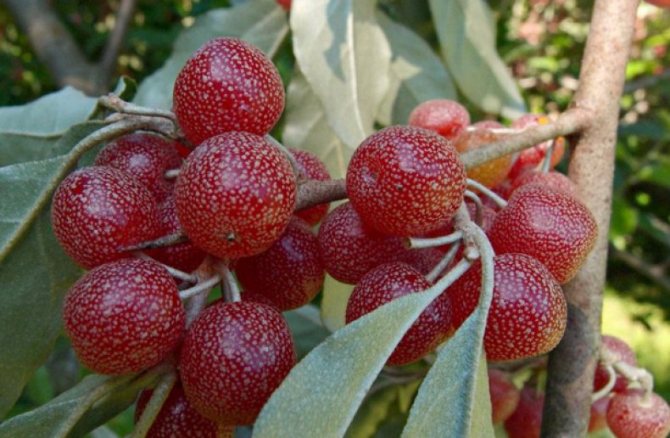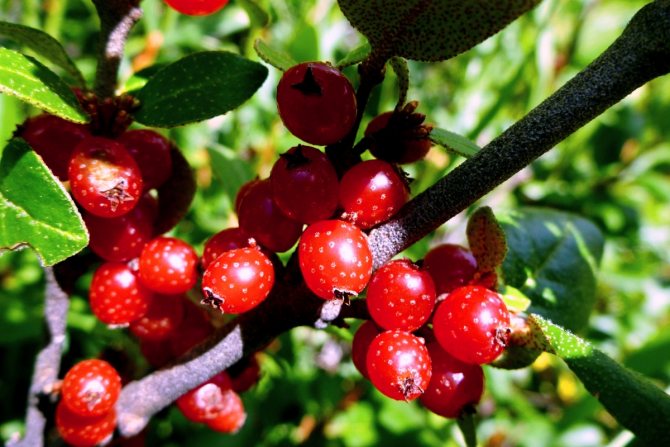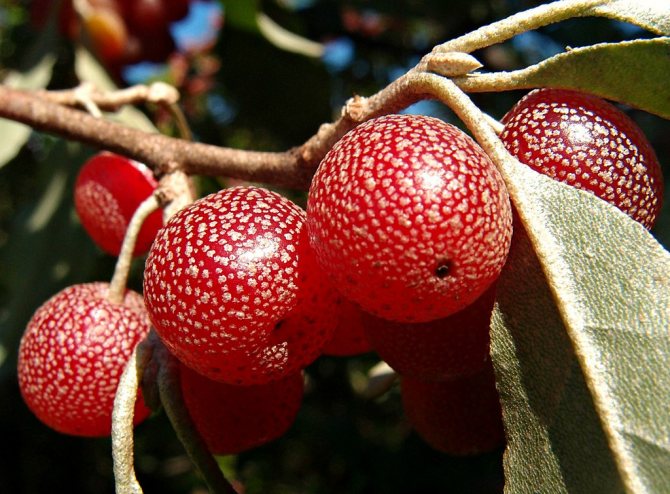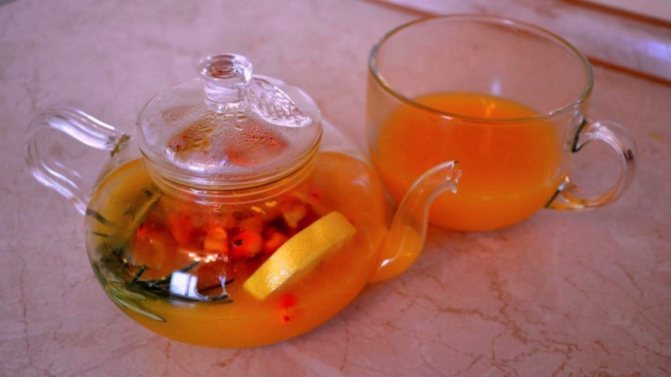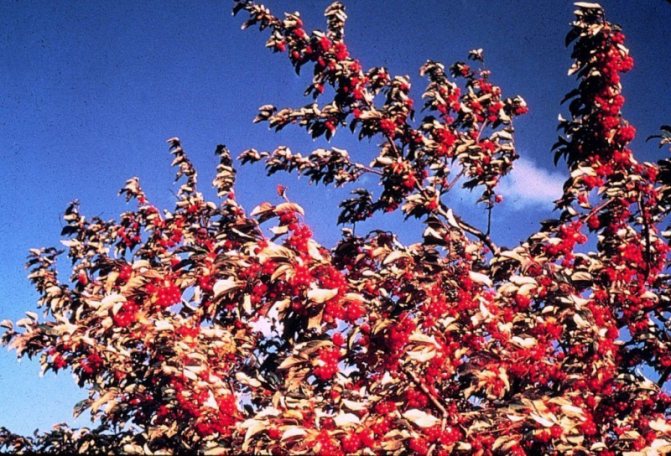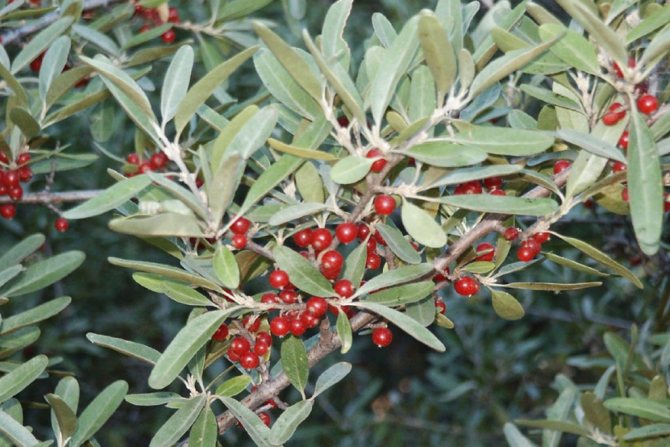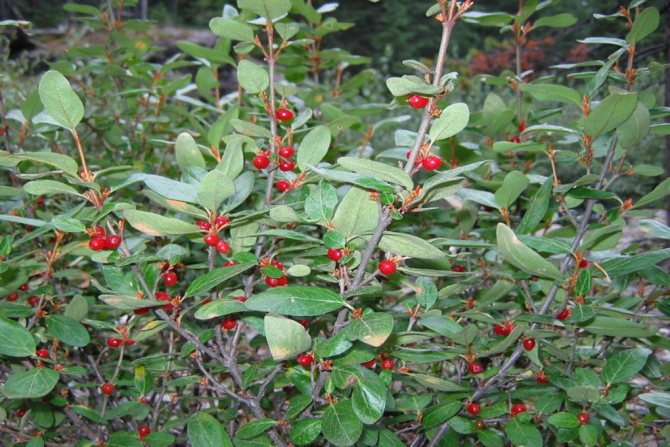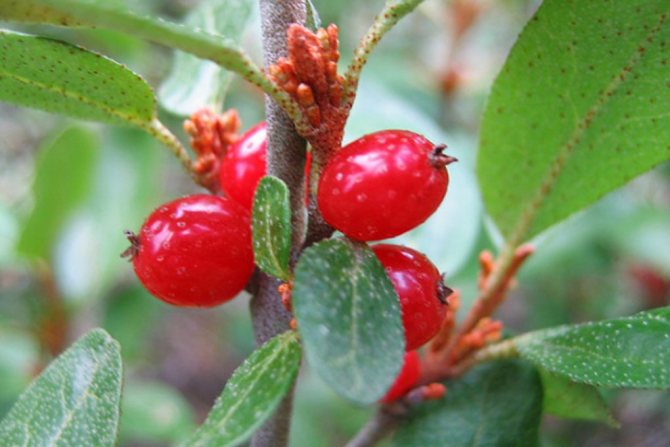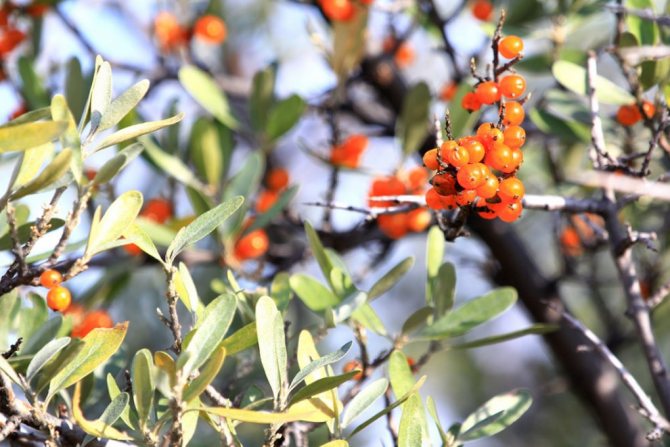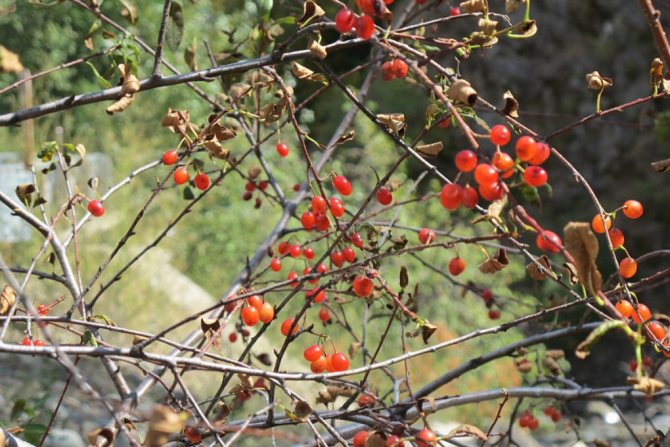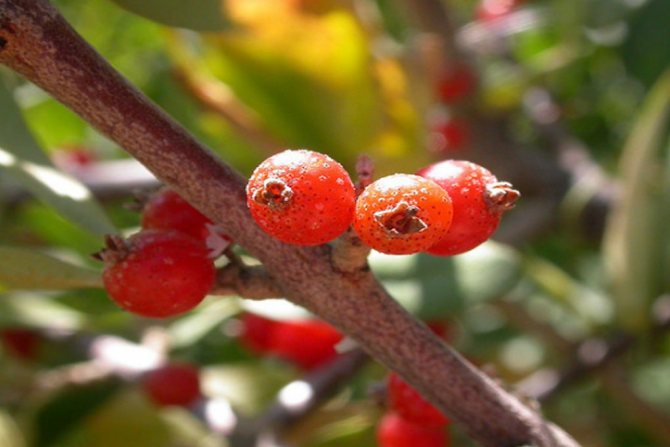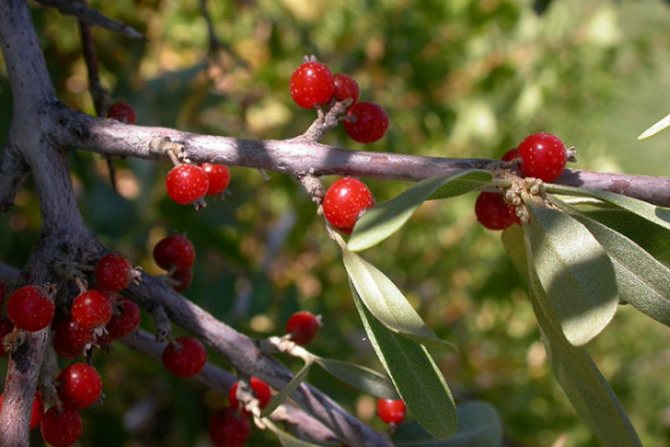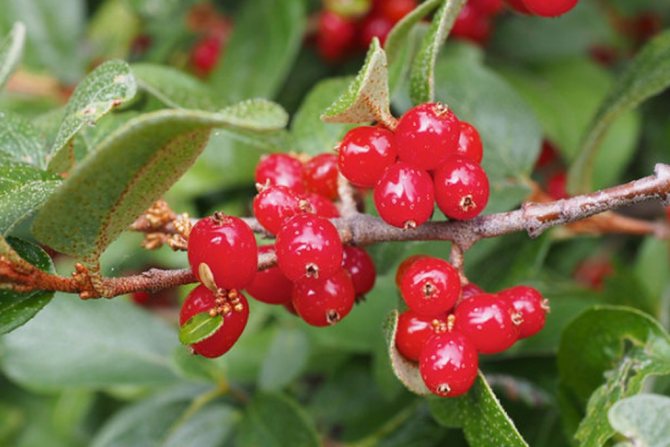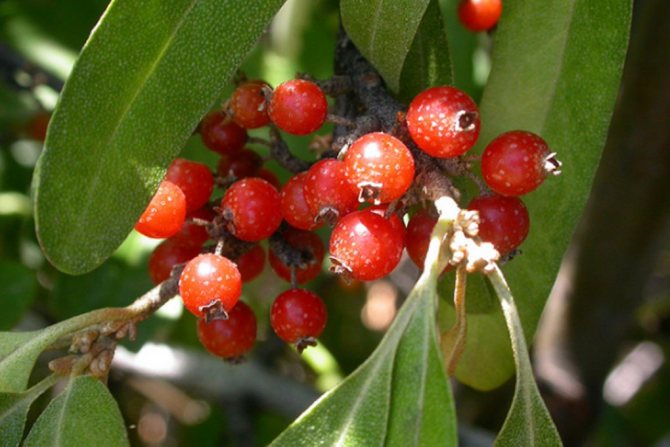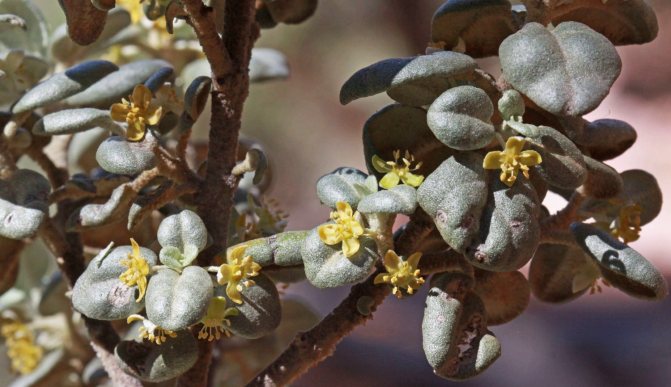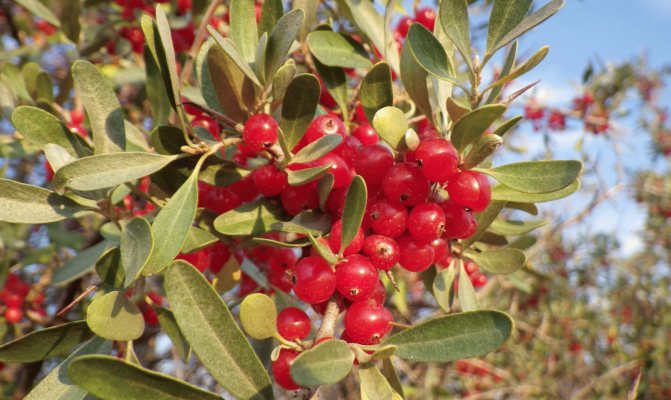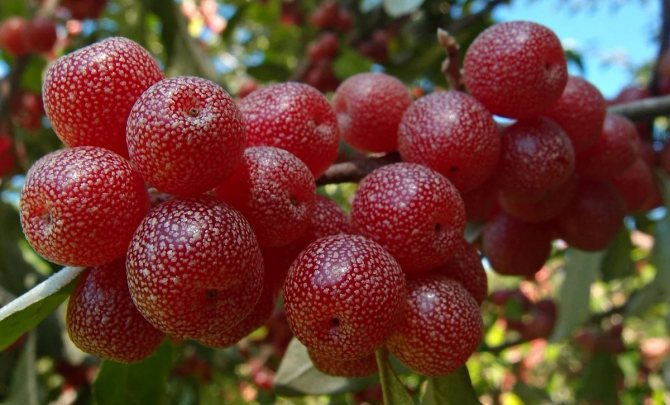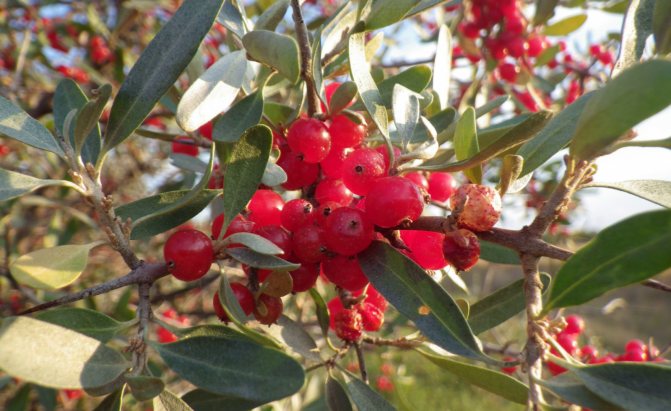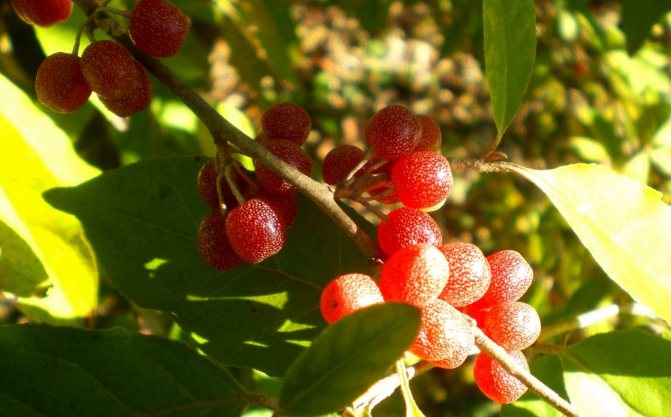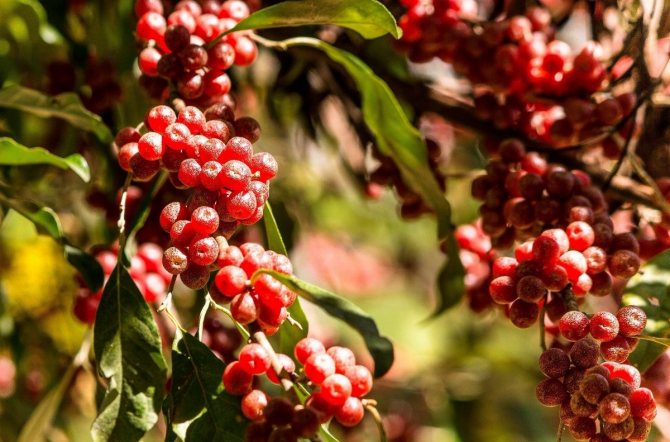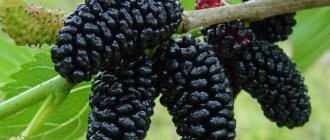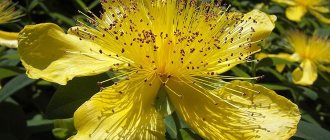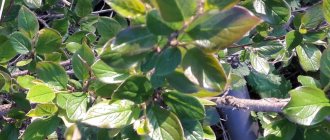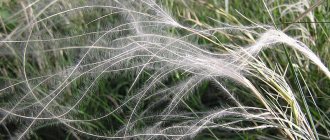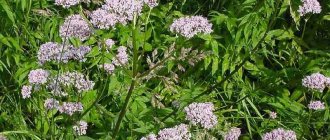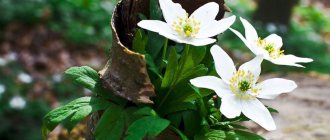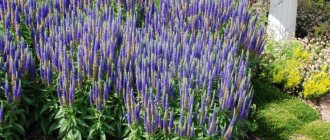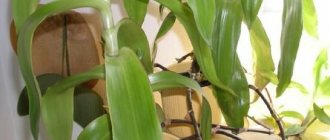What is this plant?
Shepherdia silver belongs to the Lokhovy family and is a rather undersized shrub, whose homeland is considered to be North America. The bush bears fruit with red berries, which are covered with barely noticeable whitish dots. Bushes can bear fruit annually for 40-50 years, while each can be harvested 15-20 kg of berries.

Shepherdia, also known as bison berry, is quite edible for humans raw, but it has a slightly sour-bitter taste, and after its use, the mouth feels dry. These berries serve as a source of food for many wild animals, primarily for bears, in addition, they are eaten by the larvae of some insect species.
What Shepherdia looks like
Shepherdia (Sheferdia) is a genus of perennial shrubs belonging to the Lokhovye family (Elaeagnaceae). In Russia, it is still little known, its closest "relative" sea buckthorn is much more widespread. However, at home (USA, Canada), as well as in European countries, this plant is widely used in landscape design. The silvery leaves and blood-scarlet shepherdia berries contrast very effectively with the dark green needles; it also looks good against the background of plants with red foliage (barberry, irga, weigela).
Shepherdia is widely used in landscape design due to its showiness and visual appeal.
Shepherdia was opened a long time ago, in 1818. It got its name in honor of an outstanding botanist from the British Empire, John Shepherd, who was the first curator of the most famous botanical garden in Liverpool at the time. The author of the name, he is also the discoverer - Philadelphia professor of botany Thomas Nuttall. He sent the first specimens of Shepherdia across the ocean to the same botanical garden, from where they spread throughout Europe.
Shepherdia's homeland is Canada and the United States, the climate there is not too different from the Russian one
Russia (then the Russian Empire) got acquainted with the shepherd at the beginning of the 20th century thanks to the famous breeder I. V. Michurin. He became very interested in the beneficial properties and taste of the fruits of the plant, sending several specimens to his own acclimatization garden, located in Kiev. After his death, Shepherdia was not forgotten by the employees of the garden, and soon her whole plantation appeared. Most likely, this explains the fact that of all the countries of the former USSR, shepherdia is most popular in Ukraine, although it is not a particularly heat-loving culture.
Shepherdia has a good yield, besides, it is much easier to harvest than sea buckthorn.
The plant has many nicknames - "buffalo / bison berry", "hare / rabbit berry", "soap berry", "American sea buckthorn", "Nebraska currant", "crucified berry", "silver leaf". The first three are most common. Their origin is explained by the fact that the first colonizers of America used the berry to prepare a sauce for buffalo and rabbit meat, and the pulp of the fruit is soapy to the touch.
Shepherdia is a plant from the "two in one" category, it successfully combines an attractive appearance and the presence of tasty and healthy fruits
The average height of an adult shrub is 3-5 m. Most often it sheds its leaves for the winter, but there are also evergreen species.The shoots of Shepherdia are very thin, covered with a rough gray-beige bark and often spaced with long, sharp thorns. Shoots intensively branch, bend, intertwine, cross, especially near the ground, creating an almost insurmountable obstacle. This feature makes the shepherd very suitable for the formation of hedges.
Shepherdia keeps its shape well after pruning, branches intensively - this makes it an ideal plant for the formation of a hedge
The leaves are small, 5–7 cm long, dense to the touch. They are arranged in pairs opposite each other on short petioles. The leaf plate is elliptical or lanceolate, smooth, bright green in color. But from a distance it seems silvery due to the presence of small scales or villi that reflect sunlight. The reverse side of the leaf is also pubescent, even thicker than the front side.
Shepherdia leaves are bright green, but due to the presence of densely spaced villi, it seems that they are cast silver
Shepherdia's bloom is not the most spectacular sight in the world. However, its flowers are beneficial. This plant is a good honey plant, attracting pollinating insects to the site. Very small yellowish or creamy flowers, collected in cluster or spike-shaped inflorescences, bloom in early April, even before the bush is covered with leaves. Flowers do not last long, within one to one and a half weeks. They bloom as soon as the air warms up to a temperature of 7-9 ° C.
Shepherdia flowers cannot be called spectacular and outwardly attractive
Shepherdia belongs to the category of dioecious plants. This means that if it is planted not only to decorate the garden, but also with the expectation of future fruiting, it is necessary to have both "female" and "male" plants in a ratio of about 4: 1. The latter act as pollinators. You can determine which category the bush belongs to by examining the flower buds. In "male" plants, they are larger and more rounded, in "female" plants, they have a pointed tip and are tightly pressed to the shoot. "Male" flowers are devoid of a pistil, they are characterized by the presence of many stamens.
The “male” shepherdia flower is easily recognizable by the absence of a pistil
Shepherdia fruit is a medium-sized (5–6 mm in diameter) rounded scarlet or orange-red berry. Its skin is covered with multiple whitish specks that look like paint splashes. For her, this is the norm, and not some kind of exotic disease. The pulp is tender in consistency, sweet and sour. There is an astringent tart aftertaste that not everyone likes, therefore, jelly, marshmallow, jams, compotes, liqueurs, and other preparations are often prepared from berries than they are used fresh. Although practice shows that the fruits left on the bush before the first frost are much sweeter and more tender. Shepherdia is also recommended for making sauces - there is a slight sourness and piquant astringency that comes in handy.
Not everyone likes the taste of Shepherdia fruits, but they are very useful, so you can be patient
Unlike sea buckthorn, it is very easy to collect a shepherd. After frost, it is enough to spread a film, cloth or newspaper under the bush and shake it vigorously several times. The fruits ripen at the end of summer, but until that time they firmly hold on to the branches, do not fall off.
Berries are extremely healthy. The first to realize this were the natives of North America. Shepherdia contains much more vitamin C than lemon, sea buckthorn and black currant (up to 250 mg). In addition, it contains organic acids, carotene, tannins, anthocyanins, vitamins A, E, R. Shepherdia helps to increase the general tone of the body, slows down aging, helps to strengthen the immune system, fight viral diseases, colds, inflammatory processes, is used in prevention of hypertension and atherosclerosis. Also, the berries have a bile and diuretic effect.Their calorie content is small - only 28 kcal per 100 g. The only drawback is that berries can cause allergies. Therefore, their use should be treated with caution by those who already know that they have an individual intolerance to any food product.
During heat treatment, the benefits of Shepherdia berries are not lost, therefore, homemade preparations are often made from it, the taste of the fruits is significantly improved, the characteristic astringency disappears
Shepherdia is notable for its early maturity. The plant blooms for the first time two to three years after planting the seedling in the ground. An adult bush brings 12-15 kg of berries annually. The productive period is at least 30 years, simple care will help extend it to 50-60 years. With age, the yield only increases, reaching 40-50 kg.
The climate in the homeland of Shepherdia does not differ much from that which is typical for most of the territory of Russia. The shrub tolerates frosts down to -45 ° C without much damage to itself, which makes it suitable for growing in Siberia, the Urals, the Far East. Not only shoots, but also buds differ in cold resistance. The buds and leaves open, the bushes bear fruit after the most severe returnable spring frosts, which in these regions, rightly called "the zone of risky farming", are not something out of the ordinary.
What is important for gardeners, the plant does not suffer from fungal, bacterial or viral diseases, pests also do not show interest in it. Therefore, the plant does not need to be sprayed with pesticides and insecticides, which allows you to get an environmentally friendly harvest.
Nutritional value and calorie content
The product has a rather meager nutritional value, but it contains a very large amount of vitamins and other biologically active substances. The calorie content of 100 g of red sea buckthorn is only about 28 kcal.
The composition of 100 g of raw product also contains: protein - 0.5 g, fats - 0.2 g, carbohydrates - 3.7 g. The rest of the weight falls on dietary fiber and water, which any berry, based on its biological structure, pretty rich.


Existing species
There are only three members of the Shepherdia family. Breeders have become interested in this plant quite recently, so experiments on breeding large-fruited varieties have not yet yielded sustainable results. The same can be said about attempts to cross shepherdia with sea buckthorn. This direction is recognized as very promising - it is possible to combine the yield and large-fruited sea buckthorn with the shepherdia's characteristic resistance to diseases, pests, unfavorable climatic and weather conditions.
Most often in the gardens you can find the silver shepherd (S. argentea). It is a treelike shrub with thorny branches, reaching a height of 5–6 m. Young greenish-silvery shoots gradually change color to gray-brown. Leaves are medium-sized, 3-5 cm long, in the form of an ellipse with a pointed tip. Due to the characteristic pubescence, they are cast silver on both sides. Fruits 5–6 mm in diameter and weighing about 0.5–0.7 g. They ripen at the end of summer, although they acquire a characteristic color already in July.
Shepherdia silvery is most often found in garden plots.
There are breeding hybrids with bright yellow fruits - Xanthocarpa and Goldeneye. But these are recent achievements of breeders, which are still extremely rare in the public domain. It is very difficult to find them, even abroad.
Video: what silver shepherdia looks like
Shepherdia canadensis (S. canadensis) is much less common in captivity. She has an undeniable advantage - the absence of thorns, but she is capable of performing an exclusively decorative function. Its fruits are small, yellow-orange, practically tasteless. It also does not differ in its growth rate, the maximum height is 1.5–2.5 m.Leaves are grayish-green or olive, glossy shiny, ovoid.
The main advantage of Canadian shepherdia is the absence of thorns, but its fruits are rarely eaten.
The last representative of the genus is S. rotundifolia. It is an endemic plant found in nature exclusively in the state of Colorado. It does not differ in winter hardiness, therefore, it is not suitable for growing in most of the territory of Russia. Its leaves are covered with small growths, similar to warts, are very densely located on the branches. At the same time, they are quite fleshy, therefore, under their weight, the shoots tend to the ground, forming a beautiful cascade. The flowers are very small, yellowish. The fruits are not eaten.
Shepherdia round-leaved is an endemic plant in the state of Colorado that does not differ in frost resistance, which seriously prevents its distribution among amateur gardeners.
Chemical composition
Shepherdia is the best natural source of vitamins and minerals. By the amount of vitamin C included in the composition, it is able to compete with many citrus fruits. And as for the catechins and oil substances that are part of, then they overtake the world recognized leader in these parameters - sea buckthorn. The main chemical composition of the berry can be characterized as follows:
- various sugars;
- many organic acids;
- ascorbic acid;
- substances with tanning properties;
- pectin;
- carotene;
- vitamins C and P;
- lipokines.
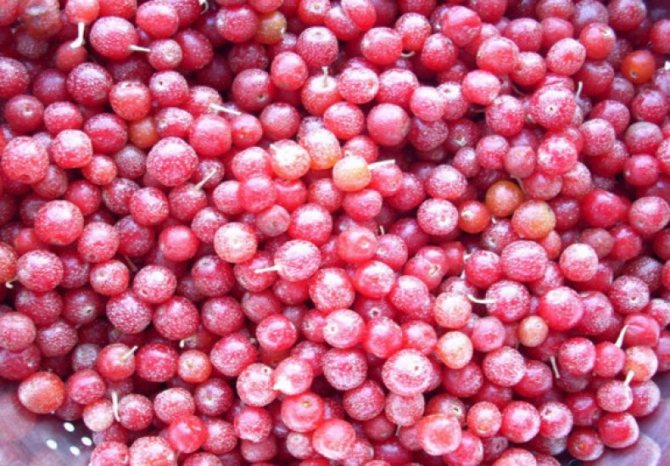

First landing specialist advice
So how do you put the shepherd in prison? To begin with, buy seedlings. You will be advised how to choose a seedling in specialized stores or nurseries. Do not forget that the plants must be both male and female. Their main difference is the shape of flower buds: in males they are large and round, in females they are oblong and small. In the spring, they will choose a place where the sun's rays constantly fall, and the depth of the groundwater is significant. Shepherdia is very afraid of flooding.
Dig holes with a diameter and depth of up to half a meter and at a distance of one and a half meters. When planting, do not forget to carefully spread the root system, but very carefully so as not to touch the small growths with bacteria that contribute to the absorption of nitrogen. When the plant falls asleep, you should not diligently tamp the earth, but water it just right so that the wet soil will cover the roots very well. The trunks are covered with small sawdust. Nurseries will tell you where to buy seedlings.
We cultivate a shepherd and take care of her
It is advisable to grow the variety of silver shepherdia in a sufficiently illuminated area, on which such conditions are: deeply drained soil with sand or loamy. This crop is not grown in places where there is high groundwater. Along with males, females are also planted, which will contribute to a good harvest.
The distance between the seedlings should be between 1.5 and 3 meters. If you do not have enough free space, then it is good to plant female plants, and graft a cutting from a male plant to the crown. Planting holes should not be too small. The required depth is up to half a meter, the width is up to 70 cm. The pits are filled with fertilized soil, two-year-old seedlings are planted in them. Freshly planted seedlings are well watered. What is this plant fertilized with? Preference is given to humus, peat, manure.
Then the trunks are kept in loosened soil, without weeds and under a layer of mulch. Shepherdia's roots are located close to the surface, therefore, when cultivating the soil, they deepen by no more than 7 cm.
It should be noted how to look after the shepherd. The peculiarities of care are that the offspring from the roots are systematically removed if they are not needed for further seedlings. Removal is carried out by carefully cutting off young shoots from a horizontally located root using a pruner or knife.
The plant should resemble a tree, so the crown is systematically pruned, leaving a height of 2-3 meters and cut. Every year the plant tends upward less and less, the yield falls, therefore, every 5 years, rejuvenation is carried out by cutting off the main and side branches. Thanks to this pruning, the shoots grow faster and the fruits become larger.


Features of this plant
Shepherdia belongs to the category of unpretentious plants: it will grow in any type of soil, in winter it is not afraid of frost, and in summer it is not afraid of drought, and is also able to grow and bear fruit in any zone of winter hardiness. They note that Shepherdia is practically not susceptible to diseases and pests. There are no diseases that will negatively affect her growth and cause unique harm to her. It is the winter hardiness of this bush that contributes to its early flowering. Moreover, the flowering period of this plant is two weeks.
There is also no need to worry about the harvest. The berries ripen in late summer - early autumn, but do not fall off for a very long time. Although it is more convenient to collect them from the ground, since there are thorns on the branches of the shepherdia, which injure the hands. What else to pay special attention to is the beauty of the bush, therefore it is grown not only for the sake of fruits, but also as a decorative masterpiece.
Shepherdia's positive qualities
The berries of this plant are very rich in vitamins and minerals, and in terms of vitamin C content they are not inferior to citrus fruits. As for catechins and oil substances, there are much more of them than in sea buckthorn. Therefore, Shepherdia berries are a real source of health and longevity. What are the beneficial properties contained in Shepherdia? It all depends on the chemical composition, which includes:
- sugar;
- ascorbic acid;
- carotene;
- vitamins C and P;
- organic acids;
- pectin;
- lycopene.
Shepherdia fruits treat diseases such as:
- cardiovascular;
- colds and flu;
- viral;
- oncological;
- increase immunity;
- stabilize pressure.
It should be noted that there are no special contraindications for the use of Shepherdia fruits. But still, as with the use of all medicinal drugs, they observe moderation.
The berries are stored frozen or dried. Moreover, each hostess has her own way of harvesting. And there are a lot of recipes. They are used for the preparation of compotes, medicinal tinctures, jellies, preserves and jelly. The fruits are used in cooking for baking cakes, making meat and fish sauces, and added to desserts.
Pharmacological properties
The fruits of shepherdia silvery have many pronounced beneficial properties. The leukoanthocyanins and catechins contained in them help to increase the strength and elasticity of the walls of veins, arteries and arterioles, and also reduce their fragility. Carotene, which is present in abundance in fruits, helps to improve the functioning of the visual analyzer and prevents the development of many ophthalmic diseases.
In addition, carotene is the initial substance that our body needs for the synthesis of vitamin A, and therefore the use of red sea buckthorn has a positive effect on the condition of the skin.
Vitamin C, which is part of the berry in large quantities, helps to increase and strengthen the immune function of the body, helps to better cope with the processes of resuming normal work after suffering various acute respiratory viral infections and influenza.
Growing conditions
Shepherdia silvery is well suited for the European climate, so it can be safely chosen as a fruitful and decorative inhabitant of a summer cottage. It is frost-resistant, resistant to drought, plant diseases and undemanding to care for, gets along well with other trees, herbs, flowers.
Location and lighting
In general, the plant will quickly adapt to the planting site. It is worth considering that the "bull berry" adores the sunny side.If the American sea buckthorn receives a sufficient amount of light and heat, it will surely "thank" you, as this will contribute to a bright, abundant flowering, and subsequently the harvest will be better and sweeter.
Strong winds and even a draft will not affect the tree in any way. In addition, if it is reasonable to plant shrubs on the site, it will protect the estate from gusts of wind, making the place quiet, comfortable and secluded.
Soil requirements
For proper cultivation and effective further care of the shepherd, it is worth taking care of a suitable soil content. The plant can live on different soil compositions: rocky, sandy and even saline soils. The soil must be loose so that the roots can be enriched with oxygen and other nutrients. It is desirable that the land is fertile, so the chances of growing a beautiful tree are much higher.
Fruit application
Shepherdia is not widely used in traditional medicine, but it is actively used in folk and cooking. They can be found as components in various preparations and bioactive supplements.
Treatment
The fruits of this shrub are widely used and recommended by many traditional healers for the treatment of various viral infections and influenza, as well as an immunostimulant in the process of restoring the body from the consequences of the latter. It is widely used as a vitamin supplement to the traditional treatment of these diseases. It is used to maintain and normalize the functioning of the gastrointestinal tract and cardiovascular system.
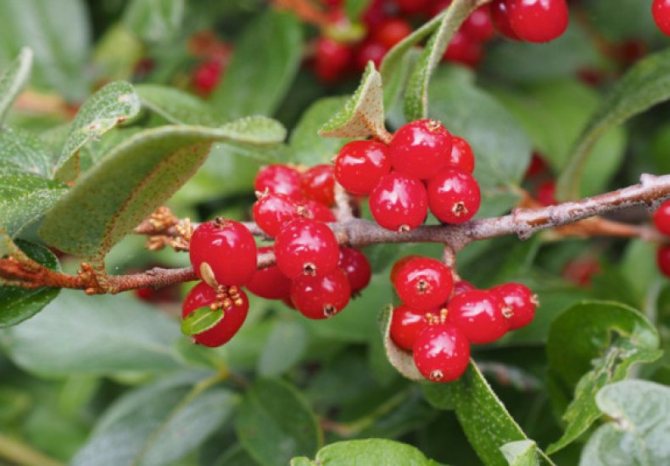

Cooking
One of the main methods of using these berries in cooking is making various alcoholic beverages from them by infusion. At one time, Ivan Vladimirovich Michurin himself spoke positively about various tinctures obtained using red sea buckthorn. In addition, it can be used to prepare compotes, jelly, preserves, jam, various sauces and unusually tasty seasonings.
Gardeners reviews
The fruits of shepherdia silver, as far as I know, are sweet and sour, it is written about this in all sources. But a relative of shepherdia silver - shepherdia canadian - really bitter fruits.
Shepherdia is just as similar to sea buckthorn, including in taste, like a turnip to a radish - only one family and the shape of the fruit - nothing else in common.
I have been growing silver shepherdia for two years now. A beautiful trouble-free bush, has not bloomed yet.
Every year I collect the shepherd. Ripe, almost cherry berry: sweet, slightly sour, astringent taste is present, but slightly. This berry is not for everybody's taste, but I really like it, I freeze it a lot and in winter we eat it like seeds. Our shepherdia does not grow in three-meter trees and, under the weight of berries, looks more like a willow.
Shepherdia is, of course, a dioecious plant. You can distinguish male and female plants only by flower buds: in males they are round, large, in females - pointed, small. Flower buds form on annual shoots and continuation shoots. Flowers are collected in short, spike-shaped inflorescences. Pollination in Shepherdia, as well as in related suckers and sea buckthorns, is cross-pollinated, and Shepherdia is insect pollinated, and sea buckthorn is wind-pollinated. I bought plants of different sexes, they are small, about half a meter, they will not bear fruit soon.
Just like sea buckthorn, shepherdia is a dioecious plant. For fruiting, it is necessary to have both a female and a male plant. For several years now, a female shepherdia plant has been blooming for me, grafted onto sea buckthorn, due to the absence of a male plant, the ovary, although it is formed, quickly falls off. It is not worth worrying about the winter hardiness of Shepherdia, it is quite frost-hardy, moreover, it is drought-resistant, not susceptible to fungal diseases.
Personally, my opinion is that if you want to keep the shepherdie because of the berries, you shouldn't! The berry, in principle, is tasty, but the viscosity characteristic of many Lokhovs does not completely come out of it. If you keep it - then only for the collection, the same "abnormal" as me, collecting on his site everything that is possible and impossible.
Growing shepherdia does not require a significant investment of time and effort from the gardener. It is enough to give it a minimum of attention so that the shrubbery will decorate the garden for many years. The plant is highly regarded for its attractive, highly unusual appearance and fruit benefits. All this contributes to the rapid growth of its popularity. Shepherdia is gradually spreading in Russia. She is quite capable of displacing sea buckthorn from garden plots, for example.
Methods for harvesting shepherdia
The most productive and fastest way of procurement is as follows. Around the bush, you need to spread some kind of tissue so that there is no gap between the stems of the plant and the tissue. Then you need to shake the stems, and the fruits themselves will fall into the bedding tissue. This manipulation is best done after the first frosts hit. This will allow the berries to acquire an extraordinary aroma and taste, similar to currant or barberry.
Read also Soup with dried chanterelles
Further, the collected fruits should be dried or made jam or compote from them, which must be further stored in a dark, not cold place.
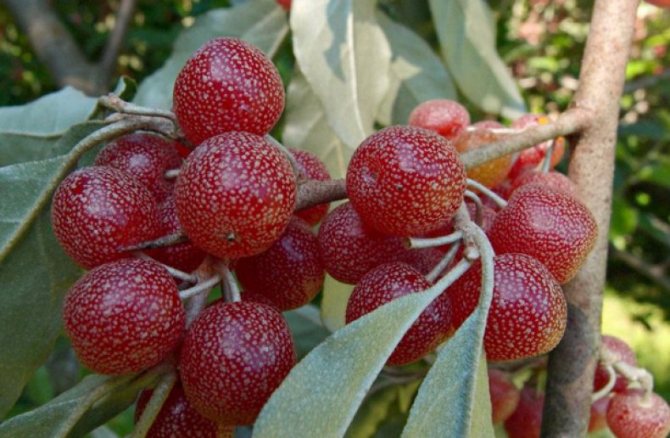

So, we hope you have extracted from this article all the necessary information about red sea buckthorn, its benefits and possible harm to the body. This bush is good not only as a raw material appendage, but also as an ornamental plant, which adds one more plus to the already vast treasury of the advantages of this plant.
Shepherdia is a sprawling perennial shrub from the Lokhovye family. It grows in North America, but is successfully cultivated in Europe. Shepherdia is also known as buffalo berry or soap berry. In appearance, Shepherdia is very similar to sea buckthorn, but the fruits of the plant contain much more nutrients and have a pleasant taste. It is not difficult to take care of the shrub, it will regularly present the owner with a bountiful harvest and delight with a beautiful appearance. It is enough to follow a few simple rules of care for the shepherdia to decorate the garden for several decades.
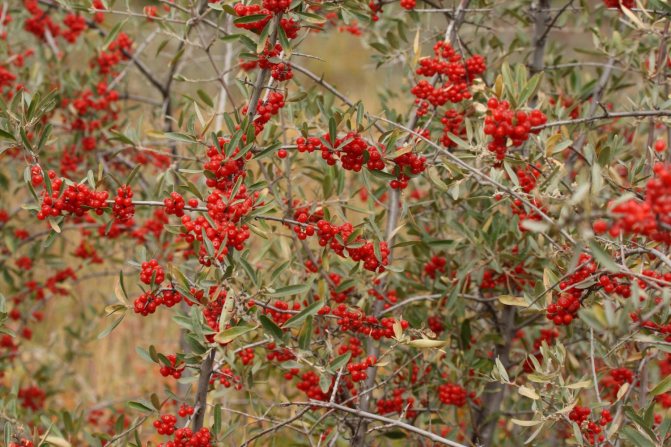

The history of the discovery of Shepherdia
In the wild, this plant was found in North America, where Indian tribes fed on its fruits and used it as a medicine for all diseases. The discoverer of Shepherdia is believed to be Thomas Natall, a professor of botany who taught at the University of Philadelphia back in 1818. And it got its name in honor of the then director of the Botanical Garden in Liverpool - John Shepherd.
Already in 1904, Shepherd was landed at the South Experimental Station in Dakota. The earliest seedlings were grown from seeds harvested along the Missouri River. Shepherdia attracted thousands of settlers with its huge yield, excellent taste of fruits and the ability to heal from some diseases.
IV Michurin played an important role in the appearance of the shepherd in the vastness of Russia. It was thanks to his three seedlings, which he sent in 1926 to the outstanding academician Kashchenko, that its acclimatization and mass cultivation became possible. At the very beginning, these were exclusively botanical gardens, then arboretums. 60-year-old plants have survived to this day. Male species reach a height of almost seven meters, their crown diameter is about 12 meters. Females, on the other hand, are slightly taller, and their crown is more than 15 meters.
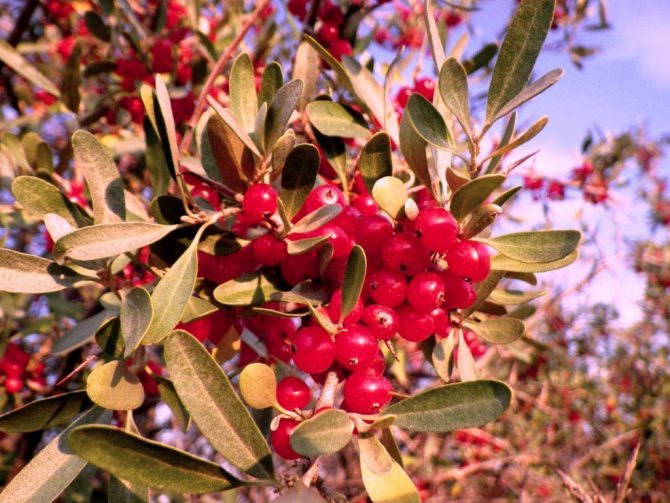

What does this plant look like
Shepherdia has the appearance of a spreading bush that reaches six meters in height. There are cases that after pruning it has one trunk, and it looks very much like a tree. Its branches are quite powerful, which are intertwined.It is on them that there are quite sharp thorns. Young shoots are always silver in color, but over time, the shoots become brown in color.
Shepherdia leaves are oblong, covered with a small fluff on both sides. Shepherdia throws out flowers even before the leaves appear on her. The flowering period is from April to early May and lasts no more than two weeks. The flowers are small, yellowish inflorescences. This shrub belongs to the dioecious family and has cross-pollination. The male plant has large flower buds in the shape of a circle. The female plant has small buds with pointed tips.


We decorate our site
In landscaping, this plant is beautiful both alone and in groups. The silvery shrub will go well with needles or dark green leaves of any tree species. In addition to its silvery color, the uniqueness of Shepherdia lies in its beautiful red fruits, which are beautiful in summer and autumn. This plant is quite dust and gas resistant, so it is planted in urban areas.
As for the shepherdia silvery, its shoots are carefully protected by thorns, which makes it possible to use this shrub as a hedge. At the same time, experts recommend planting seedlings in a row at a distance of about half a meter, or apply a checkerboard pattern, then the distance is increased to one meter. In order to give the plants the desired shape, they are cut off. Seedlings and seedlings are usually planted in the ground in spring, but autumn is also fine. Since the root system is good here, it is required to dig holes with a depth and diameter of 70 centimeters. Shepherdia is gaining more and more popularity in ornamental gardening.
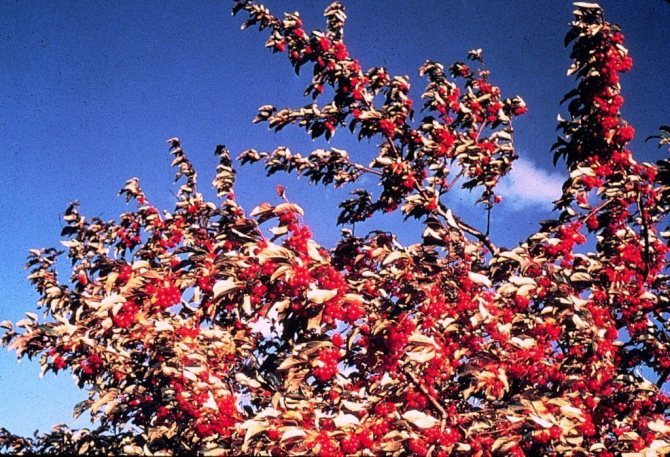

Description of the plant
Shepherdia is a perennial shrub plant 3-7 m high. Evergreen and deciduous forms are found in the genus. Thin branches are covered with rough yellowish-gray bark. They are highly branched along their entire length and covered with long spines. The branches are densely intertwined and bent to the ground, forming an impenetrable thorny hedge.
Shoots are covered with lanceolate or oval bright green leaves. Foliage on short petioles is opposite. The length of a dense leaf plate is 4-7 cm. On both sides or just below, there is a silvery bloom in the form of short scaly villi.
From the end of March, miniature axillary flowers bloom, collected in spike-shaped inflorescences. Flowering occurs before the leaves appear. The buds are attached to the shoots with short pedicels, they densely cover the branches. Shepherdia is a dioecious plant, that is, there are specimens exclusively with male or female flowers. To achieve fruiting, it is necessary to plant at least one male plant per 7-10 females in the garden. Female buds bloom a little earlier than male buds. Pollination occurs with the help of insects, after which small rounded berries ripen.
There are many small white dots on the surface of the red drupe skin. Delicate edible pulp has a sweet and sour taste. Due to the pronounced astringency, shepherdia fruits are often consumed not raw, but as part of jams, jellies and compotes. The fruits are stored on the branches until frost. Low temperatures make them softer and sweeter. Inside is a single flattened seed. Flowering and fruiting occurs 2-3 years after planting. Ripe drupes are easily crushed from the branches, which makes harvesting easier. One plant can give up to 15 kg of fruit per season.
Description and photo
Shepherdia is usually called one of the three genera of the Lokhov family. This family actually includes the goof and the sea buckthorn itself. Shepherdia is a small, thorny or non-thorny shrub that grows up to 4 meters in height. This is a dioecious plant, the genus of which experienced gardeners have learned to distinguish by flower buds.In male bushes, they are round and large, and in female bushes, they are sharp and small.
The plant has small oblong leaves up to 7 centimeters long with fine down. It blooms even before the leaves themselves bloom in the second half of April, the inflorescences are small and yellow. Did you know? Among the people, foreign sea buckthorn has more than 20 names, the most popular is "bull berry", since it is customary to use beef with Shepherd's jelly.
The plant begins to bear fruit already in the second year of life. The fruit of Shepherdia is round, deep red berries with white dots, the diameter of the fruit reaches 0.5-1.5 centimeters. These berries are edible for humans and animals, birds are terribly fond of them. The fruit tastes sour with a slight bitterness and very tart. They ripen by the end of August.
Find out more about the variety and cultivation of sea buckthorn, as well as the fight against plant diseases and pests.
Common types
The small genus of Shepherdia has only 3 species.
Shepherdia is silvery. The variety got its name from the whitish pubescence that is present on young branches and leaves on both sides. This thorny shrub can grow up to 6 m in height. Flowering begins in mid-April. On male plants, flowers are collected in miniature spikelets. Female buds are arranged singly. In September, the fruits ripen - red or yellow-orange berries. The decorative variety Goldeneye is very popular. Ripe fruits on it are colored bright yellow.
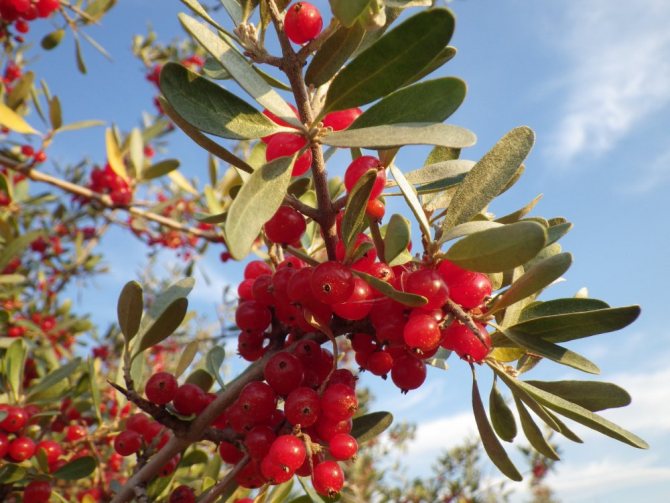

Shepherdia is Canadian. This species resembles a spreading tree in shape. Branches are covered with brown bark. The upper part of the leaves is smooth, dark green. Below the leaves are covered with silvery hair and yellow scales. Small green-yellow flowers bloom in mid-April. In September, ripen dark red oblong berries 4-8 mm long.
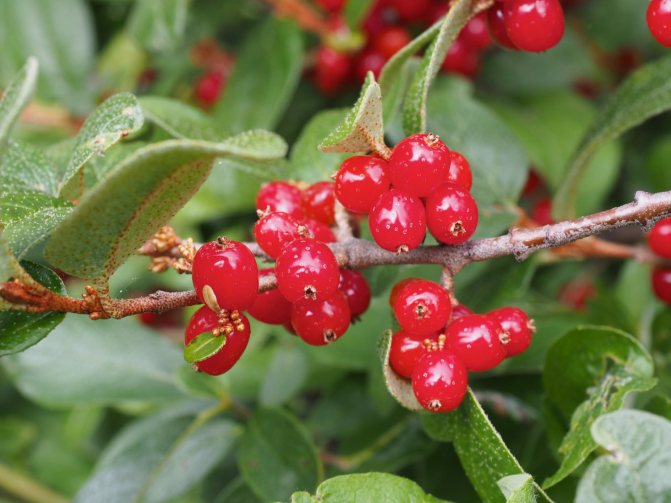

Shepherdia is round-leaved. The variety forms a tall, sprawling shrub. The branches are tightly intertwined. They are densely covered with rounded dark green leaves. On the surface of a dense sheet plate, numerous warty growths are visible. The species is distinguished by very abundant flowering and fruiting. Under the weight of the fruit, the branches bend down to the ground. Shepherdia round-leaved is practically not found outside the Colorado plateau.
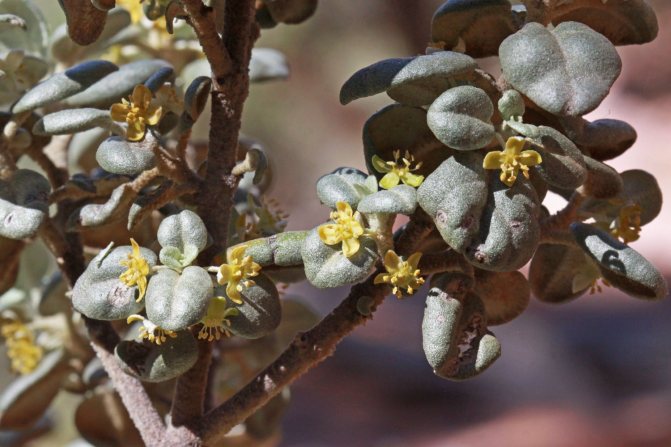

Shepherdia in landscape design
This shrub is often used to decorate the garden and landscape in urban and home gardens. Shepherdia is suitable for arranging hedges, strengthening the slopes.
In single plantings, the tree becomes a prominent accent, covered in silvery foliage and red berries. The varieties of Shepherdia Silvery for the Moscow Region include the decorative type of Goldenia. The tree is strewn with bright yellow berries.
Photos of Shepherdia Silver can be seen below.
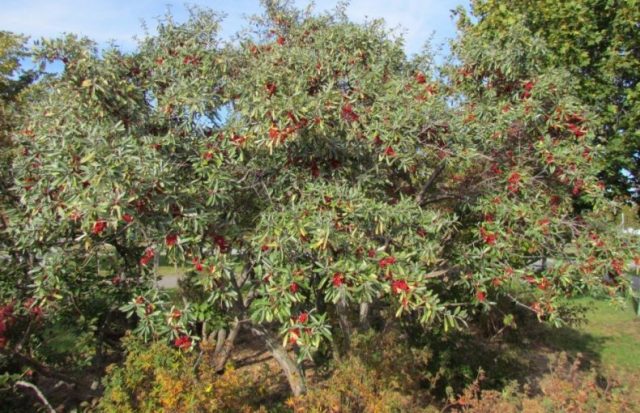

Reproduction
There are several ways to propagate shepherdia.
- Sowing seeds. Seeds should be sown outdoors in November. They are buried in the soil to a depth of 1.5-3 cm. In winter, it is recommended to cover the sowing site with snow. The first shoots will begin to appear by mid-April. In September, the length of the seedlings will be 10-15 cm. If necessary, they are transplanted to a permanent place. Flowering and fruiting is expected in 4-6 years.
- Rooting cuttings. This method is good because it allows you to immediately identify the male and female plants. For rooting, choose green cuttings with 2-3 buds. Their length is usually 8-12 cm. During the first day, the twigs are kept in "Kornevin", and then planted in sandy-peat soil. The shoot should be deepened by 3-4 cm. At the end of September, the cuttings will develop strong roots and they can be planted in the garden in a permanent place.
- Separation of root processes. Several babies are formed at the roots of Shepherdia every year.In March-April, strong plants can be transplanted from the main bush to a new location. A transplant can also be scheduled for early fall.
Read also Pump for recirculation of domestic hot water
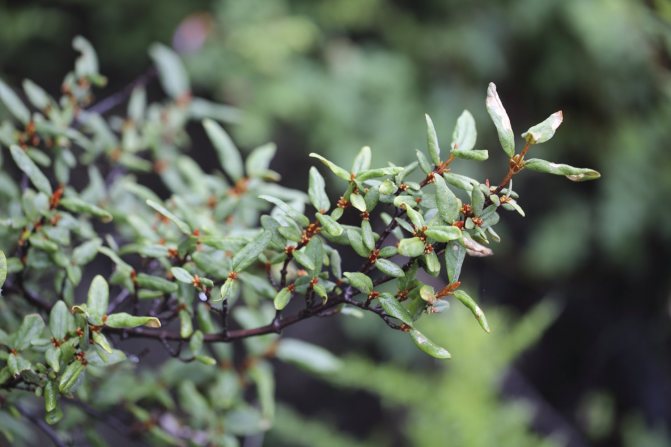

Meet Silver Shepherd
02.06.2017
Among the crops most adapted to the climatic features of middle latitudes, there is also the perennial deciduous berry shrub shepherdia. It is closely related to such plants as the elk and sea buckthorn. This plant is still little known in our country, and is very rare in garden plots. Shepherdia is sometimes called red or American sea buckthorn. Of its three species, two are widespread on our territory: silver shepherdia and canadian shepherdia, but the latter is used exclusively as an ornamental culture.
Shepherdia silvery or buffalo berry (lat. Shephérdia argéntea, Lokhovye family) is a small fruiting shrub (spreading tree) with well-branched thorny branches, up to 2-6 m high, native to North America. Differs in unpretentiousness to natural conditions, as well as regular and abundant fruiting. Possesses high frost resistance, can withstand frosts down to - 45 ° C. It tolerates drought, heat well, is resistant to gas and dust, practically is not affected by diseases and pests. Another undoubtedly positive property of Shepherdia: it enriches the soil with nitrogen due to the activity of the nodule nitrogen-fixing bacteria on its roots.
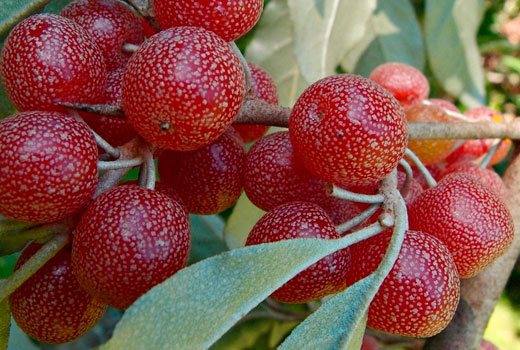

Shepherdia silvery is a dioecious crop, therefore, for its pollination, the presence of male and female plants is required. They can be distinguished by the shape of the kidneys: rounded and large are typical for the male, and smaller, with a pointed tip - for the female. Insects pollinate the plant. Shepherdia blooms early (in April), before the leaves open. Flowers are formed from four sepals, they do not have petals. Sometimes a prolonged winter thaw can provoke repeated flowering, which adversely affects the development of the plant. Fruiting occurs at the age of 2 - 3 years and lasts up to 40 - 50 years. The yield is 15 - 25 kg in young trees and gradually increases, reaching with the age of plants up to 30 - 40 kg.
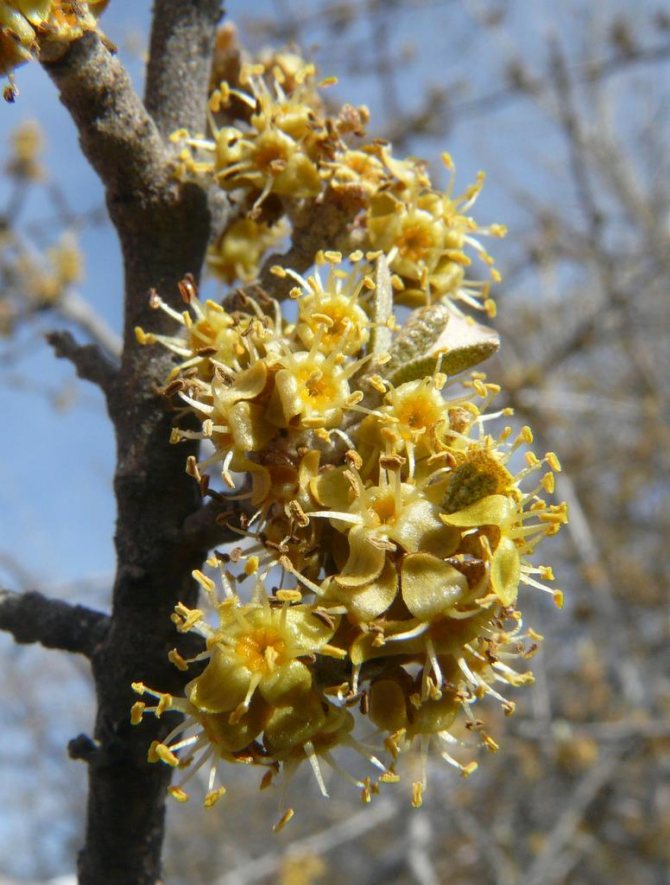

In addition to tasty and healthy berries, Shepherdia has a great decorative effect, and it is readily used in landscape design. The plant is easily formed by pruning, therefore it is often used for arranging dense, impassable and at the same time decorative hedges, protective forest belts, phyto-reclamation plantings. Red berries-beads, abundantly located on the branches, give a special elegance to the shrub. They can be stored on the plant throughout the winter. The berries are edible and very healthy. They have a sweet and sour taste with a slight bitterness and astringency, but after frost their taste improves significantly, they become sweet and aromatic.
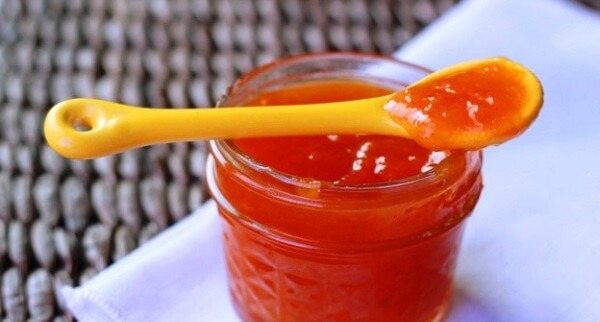

Shepherdia berries are rich in vitamins (especially C), sugars, organic acids, catechins, carotene, essential oils, P-active and tannins. They are known as a valuable food and dietary product. They are also very useful. They have anti-inflammatory and hemostatic effect. And the vitamin P contained in them has a strengthening effect on the walls of blood vessels, which significantly reduces the risk of strokes and heart attacks. Due to the significant amount of lycopene, shepherdia fruits have an antitumor effect on the body.
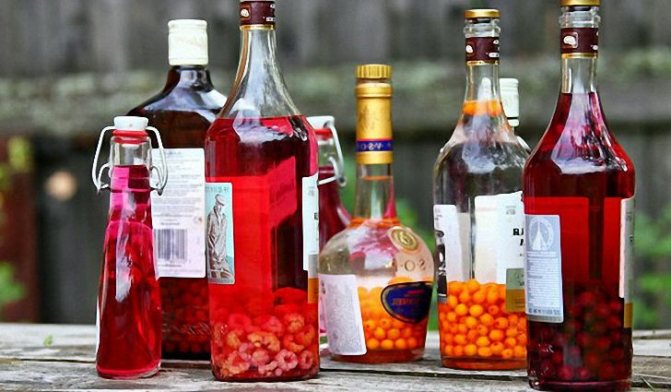

You can eat berries both fresh and processed. Dried fruits from Shepherdia are very popular. Also, crushed and grated with sugar, berries can be stored for a long time in the refrigerator without losing their beneficial properties. Compotes, juice, wine, liqueurs, jam, jam, preserves, jelly, seasonings for meat - this is just an incomplete list of dishes that are prepared from Shepherdia.The berry is contraindicated for people with individual intolerance to the product and suffering from allergic reactions.
The cultivation of this culture is not fraught with difficulties, since the shepherdia is very unpretentious. It can grow on any type of soil, except waterlogged, waterlogged and with a high level of groundwater. Loves sunny, wind-protected areas. Shepherdia prefers fertile, loose, acidic or slightly acidic soils, but it can be grown even in sandy, rocky and saline areas that are very poor in nutrients.
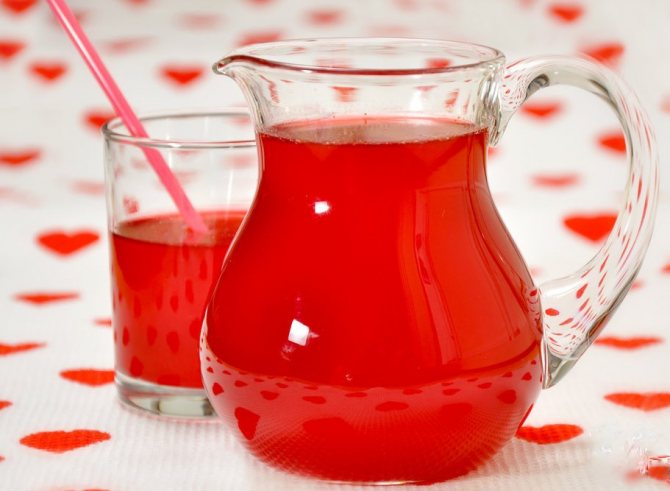

Shepherdia propagates by seeds or vegetatively (by root shoots, green cuttings, layering). It should be remembered that the germination of Shepherdia seeds lasts no more than two years, so they cannot be stored for a long time as a seed. Seeds are sown in open ground in late autumn - early winter (in warm weather). Shepherdia is characterized by abundant formation of root shoots. New shoots appear at some distance from the mother plant (up to 2 m), therefore, they subsequently grow as independent plants, and after two to three years they begin to bear fruit.
Harvesting cuttings for growing Shepherdii and cuttings are carried out in the summer, at the end of June - early July. From the most developed shoots of this year, sections are cut off containing two to three internodes, 10-15 cm long. The lower leaves are removed, one of the sections is placed in a root formation stimulator for a day. Then they are planted obliquely into a substrate of peat and sand (1: 1) to a depth of 3-4 cm. At first, the cuttings must be shaded, protecting them from direct sunlight. It is also necessary to ensure sufficient moisture of the substrate. Rooting usually ends in October, after which the plants are transplanted into open ground.
Caring for shepherdia consists in shallow loosening (up to 5 - 8 cm) of the periosteal circle, removing weeds and pruning. Pruning involves the formation of a plant either in the form of a bush or in the form of a standard tree. With the onset of fruiting, it is necessary to periodically reduce the crown of the shrubs. You should also regularly remove all frozen, damaged, sick, growing inward and thickening the crown of the branches. Rejuvenating pruning helps boost growth and yield in shepherdia.
Shepherd's care
Shepherdia is unpretentious and adapts well to living conditions. It can grow on any soil, but sand or gravel is recommended for heavy soils for better drainage. For abundant fruiting and sweeter berries, you should choose an open, sunny place. All types of shepherdia are resistant to cold weather and do not require additional shelter for the winter. Plants are also not afraid of drafts.
Shepherdia is drought tolerant and does not like waterlogging. Usually it has enough natural precipitation. Only in prolonged hot and dry weather, especially during the period of fruit ripening, can the bushes be watered with a medium portion of water.
For normal development, the plant needs regular weeding and loosening of the soil. This procedure will allow air to penetrate to the roots. Care must be taken to remove weeds and loosen the soil, as the roots are quite close to the soil surface.
To maintain an attractive appearance, the shepherd must be cut off. In the garden, the height of the plant is often limited to two meters. This makes maintenance and harvesting easier. You should also thin out the crown, otherwise the branches will get tangled and will tend to the ground.
Types and varieties
According to The Plant List, the plant has three types:
- Shepherdia canadensis is not a very common tree in our latitudes, this is due to the fact that its yellow-red berries are completely tasteless. It is extremely rare, especially as a decorative component of the landscape.
- Round-leaved Shepherdia is a tall shrub covered with unusually dark green rounded leaves. The branches of the plant during the period of fruit ripening are almost at the very ground.These trees are distributed exclusively in Colorado due to the lack of frost resistance.
- Shepherdia silvery is the most popular deciduous species found around the world. Thanks to the pubescence, the branches of the plant really appear silvery-white. Shepherdia fruits can be red or bright yellow-orange with a pronounced taste.
This species includes several well-known varieties: 'Goldeneye' and 'Xanthocarpa'. Important! Doctors warn that the fruits of shepherdia silvery cannot be consumed in large quantities, since the berries contain tetrahydroharmol, which has the property of influencing the psychological state of a person by changing mood.
Beneficial features
Shepherdia berries lead in the amount of ascorbic acid. In addition to her, the fruits contain:
- tannins;
- vitamins A, P, E;
- pectin;
- organic acids.


The use of Shepherdia fruits helps to strengthen the immune system, take care of the state of blood vessels, and normalize blood pressure. Berries can be eaten raw, made into alcoholic tinctures, and all kinds of sauces, jams and preserves can be prepared. They are more a food product than a medicine, therefore they have no contraindications. Caution should be exercised only in people prone to allergic reactions.
Shepherdia (popularly - buffalo berry, bison berry, Canadian sea buckthorn, red sea buckthorn) is a perennial shrub of the Loch family, is a close relative of sea buckthorn. Homeland - North America. In pharmacology, it has not received distribution, however, in folk medicine, its beneficial properties associated with high vitamin value are used.
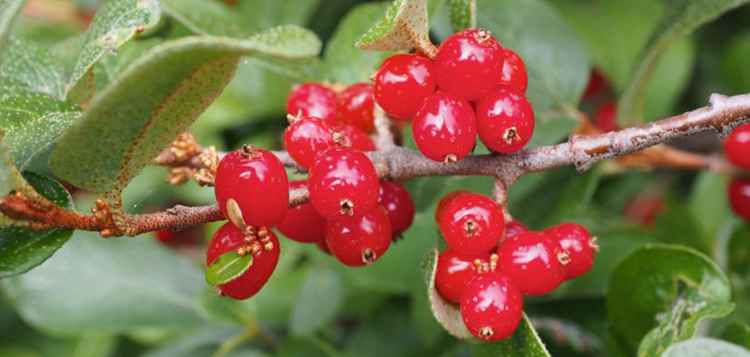

The berry has immunomodulatory, anti-aging, bactericidal properties, improves vision, memory, increases efficiency and has many more beneficial properties for the body, about which you will be able to find out of articles.
Planting scheme for seedlings
Planting American sea buckthorn is very easy. It is better to do this in spring (in April), so that the young plant has time to take root well and get stronger before the onset of winter cold weather.
Consider the step-by-step instructions for planting the "bovine berry":
- We choose a high-quality seedling aged 1-1.5 years.
- We dig a hole, the depth of which is up to 40 centimeters.
- We add sand there to make the soil softer, as well as fertilizer (the presence of these components together with the earth should be in a 1: 1: 1 ratio).
- We carefully remove the seedling from the container so as not to disturb the root system of the plant.
- We immerse the shepherd in the pit and sprinkle with soil.
- From above, do not water the tree too abundantly with water.
It is recommended to place seedlings at a distance of 20-40 centimeters from each other. After planting shepherdia, moisturizing will become the most important component of care. It is recommended to water young American sea buckthorn seedlings regularly twice a week and for at least three months from the moment of planting. Adequate amount of water will have a good effect on the growth and development of the shrub. We advise you to read about the beneficial properties of gumi berries (multiflower goose), as well as how to grow a shrub in the country.
Structure
Among the people, Shepherdia is most often used to prevent colds and strengthen immunity, due to its high vitamin value. In terms of vitamin C content, it is ahead of citrus fruits, and in terms of the amount of organic oils - sea buckthorn. So, 100 g of plant fruits contain:
- vitamin C - 250 mg;
- vitamin P - 529 mg;
- catechins - 18-19 mg;
- oily substances - 8-10 mg in seeds and 1.2 mg in pulp;
- tannins - 0.6 mg;
- organic acids - 1.2-4 mg;
- sugars - 12-21 mg.


Also, raw materials are a good source of vitamins E, A and pectin substances. Nutritional value of berries (per 100 g): proteins - 0.5 g; fats - 0.2 g; carbohydrates - 3.7 g.
Breeding Shepherdia
Shepherdia successfully reproduces in both vegetative and generative ways.In this case, the bushes obtained from seeds fully inherit the varietal characteristics of the "parent" plant. This does not apply only to hybrids bred by breeding, but they practically do not occur in Russia.
Germinating seeds
Shepherdia seeds are harvested on their own, grinding the pulp of the largest berries into a pulp. Then the container with them must be placed in the sun. When the pulp is dry, the seeds can be easily separated from it.
Shepherdia seeds are easy to collect on your own, it is advisable to plant them in the same year when they are harvested
They are planted in the same autumn, over time, germination significantly decreases. For seeds harvested in the same season, it is about 80%. It is impractical to store planting material for more than two years. The best time for disembarkation is the first decade of November. The ratio of "male" and "female" plants among the obtained seedlings is approximately equal, so there is no need to worry about this.
- The collected seeds are planted immediately in open ground. They do not need to be deeply buried, 2-3 cm is enough. An unheated greenhouse is ideal for this purpose. In order not to lose the landing site, you can dig a small box into the ground in advance. An alternative to this natural stratification is keeping the seeds for 6–8 weeks at a temperature of 0–2 ° C. In this case, they are planted in the ground in April or May, but their germination capacity is significantly lower - no more than 60%.
- The plantings are mulched with peat or humus, creating a layer 8–10 cm thick. As soon as enough snow falls, a snowdrift is poured onto the garden bed.
- The first shoots should appear in the second decade of April. During the season, the seedlings are looked after as if they were mature plants. Until the end of July, it is advisable to carry out 2-3 fertilizing with nitrogen-containing fertilizers - they stimulate the growth of green mass.
- By the end of autumn, the seedlings will reach a height of 12-15 cm. Such plants can be transplanted to the intended area. The first harvest from a shepherdia grown from seeds can be expected in 5–6 years, but this period can extend to 8–10 years.
Shepherdia seeds planted in open ground before winter show better germination than those that germinate at home
Propagation by root layers
The shepherdia obtained in this way bears fruit within 3-4 years after rooting. Dense growth is formed at a distance of 1.5–2 m from the bush. Layers take root best at the age of two years.
Reproduction using root shoots is a method provided by nature itself. Planting material is carefully removed from the soil along with the roots
- The soil is dug up, the layers are carefully separated from the mother plant. It is necessary to make as few incisions as possible, traumatizing the roots to a minimum.
- The "wounds" inflicted on the offspring are disinfected by sprinkling with crushed chalk, activated carbon, sifted wood ash, and cinnamon.
- Layers are planted in a chosen place, watered moderately. If it's not too warm outside, they are covered with cut-off plastic bottles. In extreme heat, plantings are protected with a white covering material. As soon as new leaves appear, the shelters can be removed.
Cuttings
Shepherdia stalk is the tip or middle part of an annual shoot 10–12 cm long. They are cut at an angle of approximately 45º. It is desirable that it be non-lignified, such cuttings root much faster. You can cut planting material throughout the season, but the optimal time for this is the end of July or the first half of July.
Shepherdia cuttings, best suited for propagation - tops of annual shoots
- The lower cut of the shoot is soaked for about a day in a solution prepared according to the instructions of any root formation stimulator. You can just sprinkle it with Kornevin, Heteroauxin, Zircon powder.
- Small pots or plastic cups are filled with sterilized seedling primer. The substrate is well moisturized.
- Cuttings are planted in the soil, deepening 3-4 cm at an angle of about 60º.If necessary, the lower leaves are cut off. Sprinkle the soil with a thin layer of sand (1–2 cm). It is imperative to create a greenhouse effect by placing containers in bags, covered with glass caps or cut plastic bottles. The cover is removed for 5-10 minutes every day to avoid condensation.
- Cuttings provided with bright diffused light for 8-10 hours a day and a temperature of 22-25 ° C give roots in 20-25 days. They also need to be sprayed daily with water at room temperature. The soil should not be allowed to dry out, and direct sunlight is also destructive for the cuttings.
- At the end of September or in the first decade of October, rooted cuttings are transplanted to a permanent place.
Shepherdia cuttings are propagated in the same way as other berry bushes.
Beneficial features
The most pronounced properties of Shepherdia - anti-inflammatory, astringent, bactericidal and hemostatic - are due to the presence of a large amount of tannins in it. Biologically active substances that make up the plant, contribute to:
- strengthening immunity;
- excretion of bile;
- rejuvenation of the body;


- reducing the risk of viral infections;
- normalization of blood pressure;
- improving the condition of blood vessels, eliminating their fragility and permeability;
- normalization of digestion;
- reducing the risk of developing atherosclerosis;
- relieving stress and neuroses;


- recovery from colds suffered;
- reduce the risk of heart disease;
- removing excess water from the body;
- improving the condition of the skin;
- healing wounds;
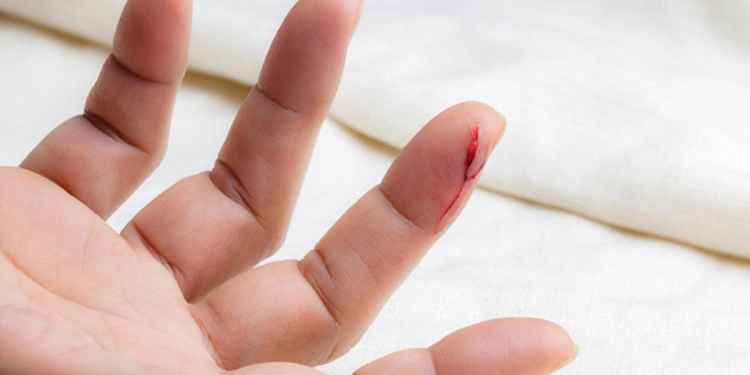

- reduction of inflammatory processes in the intestines;
- improving metabolism;
- prevention of myocardial infarction and strokes;
- improving memory;
- maintaining eye health.


Read also At what distance to make a septic tank from home
Breeding Shepherdia
There are 3 ways to breed red sea buckthorn.
Seminal
Crop seeds can be harvested by yourself The largest berries are selected and left in the sun. Once the pulp is dry, the seeds are cleaned. They are planted immediately in the fall in open ground. During storage, the germination of the seed decreases.
The disadvantage of this method is that it is impossible to immediately determine what gender the plant will be. The optimal time for planting seeds is early November. They are buried 2-3 cm into the ground and mulched with humus. The thickness of the mulch is 8-10 cm.
When a snow cover forms, a snowdrift is thrown onto the garden bed. The first shoots appear by mid-April. They are fed with nitrogen fertilizers 2-3 times to accelerate the growth of green mass. By autumn, the shrub grows up to 12-15 cm and is transplanted to a permanent place.
By cuttings
This method is more popular than the previous one. Cuttings are harvested in late June and early July. For this, the apical or middle part of a non-lignified annual shoot is suitable. Cut them off at an angle of 45 °.
For a day, the lower cut of the cuttings is left in a solution of a root formation stimulator - "Kornevin", "Heteroauxin". Then they are planted in small cups filled with sterilized and moistened soil, at an angle of 60 °.
The cuttings are buried 3-4 cm, removing the lower leaves. Be sure to make sure that the soil does not dry out. It should always be moist. The cups are covered with polyethylene and placed in a bright place without direct sunlight. Rooting takes place at a temperature of 23-25 ° C for 20-25 days.
Root offspring
This is the easiest breeding method. The bush gives a lot of growth that must be removed. From the mother plant, it is formed at a distance of 1.5-2 cm. It is better to use 2-year-old layers for reproduction.
Dig up the soil and carefully separate the offspring. All sections are sprinkled with crushed activated carbon or wood ash for disinfection. Then they plant it in a permanent place and water it well.
If it is hot outside, then cover the plant with a white covering material. In cold weather, a cut-off plastic bottle. Shelters are removed when new leaves appear on the cut.
Application in traditional medicine
Useful properties of buffalo berries at home are used in medical and preventive purposes for:
- fight against viral and infectious diseases - influenza, acute respiratory viral infections, acute respiratory infections, colds (as an additional tool to traditional basic treatment);
- cancer prevention;
- stabilization of blood pressure;


- increasing the body's resistance during periods of seasonal epidemics (fresh, in the form of dried fruit powder, tinctures);
- accelerating the process of recovery and recovery from illness (as a vitamin supplement);
- for diseases of the digestive system (in the form of tinctures, fresh and dry);
- strengthening of blood vessels (tinctures, fresh, dried berries);
- maintaining heart health (vitamin supplement to the main diet);


- prevention of atherosclerosis (fresh, in the form of a powder of dry berries, tinctures);
- stopping bleeding;
- improving the condition of the skin (eating shepherdia fresh).
Shepherdia gives a very good effect when used for cosmetic purposes as part of face masks. High content of vitamins C, E and A, organic oils and pectins contribute to:


- alignment of complexion;
- making the skin velvety;
- reducing the number of fine wrinkles;
- giving the skin elasticity.
The subtleties of growing
There are several nuances to keep in mind when cultivating Shepherdia.
Mandatory presence of male and female trees
As mentioned above, this is a dioecious plant, that is, on one shrub there are only female flowers, on the other - male ones. To get a crop, both a female and a male plant must be planted. The optimal amount on the site is considered to be 4 female plants and one male. They are distinguished by the shape of the buds and the structure of the flower.
The female plant has a pointed tip of the bud, the latter are tightly pressed to the shoot. In the male, the kidneys are larger and more rounded. They lack a pistil in flowers, but you can see 6 long stamens. Pollination takes place with the help of insects.
We recommend reading an article on how to plant and grow sea buckthorn.
Timing of fruiting and frost resistance
Depending on the method of reproduction, the shrub begins to yield crops at different times:
- After planting the seeds, the first berries can be tasted in 5-6 years, sometimes the terms can last up to 10 years.
- When planting a root sucker or cuttings, the crop is obtained for 3-4 years.
The plant easily tolerates severe frosts and can withstand temperatures as low as -45 ° C. It can be grown, including in regions with risky farming - in the Urals or Siberia.
You can read how to care for sea buckthorn in the autumn.
Soil requirement
Shepherdia is undemanding to soil. In nature, it grows on rocky, sandy or saline soils. This is due to the fact that the roots of the plant themselves extract nitrogen from the environment with the help of nodules.
However, she will be "grateful" if she is planted in fertile soil with good air permeability. The only condition is the occurrence of groundwater by more than 1 m.
Traditional medicine recipes
At home conditions for medicinal purposes use fresh shepherd, in the form of freshly squeezed juice, decoctions, infusions.
Preparation of infusion
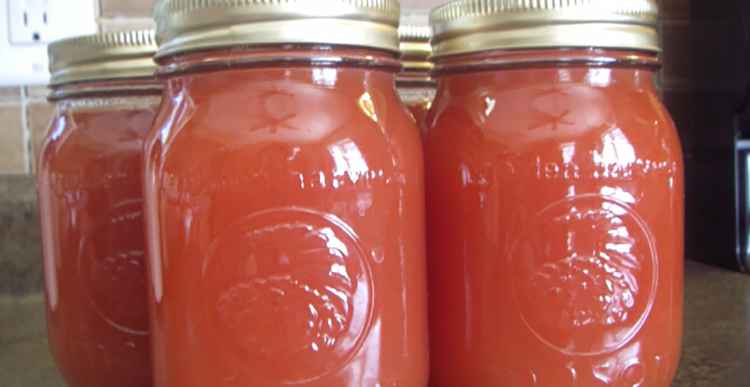

Dried raw materials (1 tablespoon) are poured with boiling water (250 ml), wrapped and insisted for 15-20 minutes. The tool is recommended to be taken for:
- increasing immunity;
- strengthening of blood vessels;
- maintaining heart health;
- cancer prevention;
- prevention of atherosclerosis;
- stroke prevention;
- in the complex treatment of diseases of the gastrointestinal tract.
Also, for the prevention of colds and viral diseases in the morning, you can drink tea from fresh fruits, which are poured with boiling water and insisted for 5-10 minutes. You can improve the taste of this tea and increase its vitamin activity by adding fresh currant berries to it. The oil made from the fruits of the bush has healing properties.
Making Shepherdia Butter
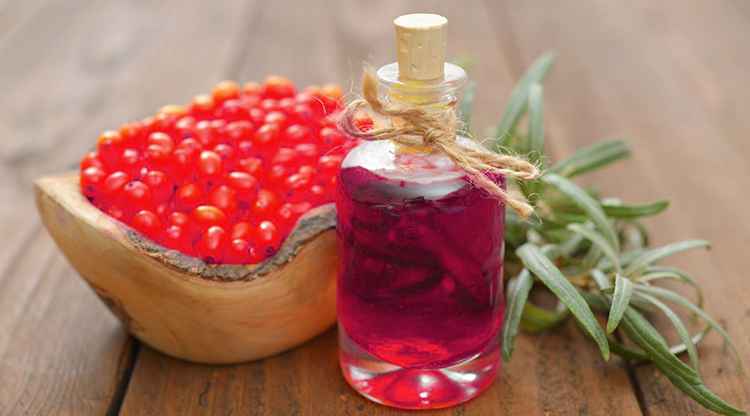

For cooking, you need to: rinse the fruits, dry in the oven and grind with a coffee grinder. The resulting powder is poured with olive oil (two parts of oil are taken for one part of the powder), poured into a glass dish and left in a dark place for 7-10 days. Such oil is used at:
- diseases of the gastrointestinal tract;
- skin ailments;
- hypertension (an infusion consisting of herbs of motherwort, creeper, wild rosemary and horsetail will also help reduce pressure);
- frostbite;
- burns.
When taken internally, the dosage should be observed: 1 teaspoon per day 15-20 minutes before meals. To increase the effectiveness of the treatment of the stomach, you can use products containing arrowhead herb.
Instructions for the use of preparations from shepherdia silvery
Fresh berries, compotes, jelly, mousses, jellies and shepherdia berry liqueurs can be eaten without any restrictions.
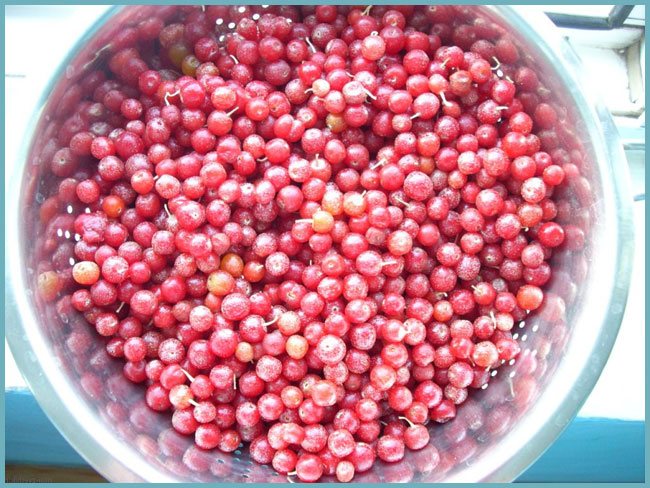

Various desserts can be made from berries
For medicinal purposes, alcohol tincture should be consumed 3 times a day for a month, then you need to take a break for a period of 30 days.
Important! It is not necessary to carry out treatment with shepherdia berries and preparations from them during pregnancy and lactation.
Shepherdia properties: video
Why Shepherdia is useful: photo
Contraindications for use
Using red sea buckthorn in nutrition and treatment, it must be remembered that it can bring and harm:
- people with individual intolerance to plant components;
- pregnant and lactating women;
- people suffering from stomach ulcers;
- having inflammatory processes in the duodenum.
Shepherdia fruits contain the substance tetrahydroharmol, which has a psychedelic effect on humans. Therefore, it is recommended to observe the measure in their use in food.
In the presence of chronic diseases and during their exacerbations, it is necessary to take funds that include red sea buckthorn after consultations with your doctor.
Plant features
Red sea buckthorn, buffalo berry, bison, rabbit - these are all the names of Shepherdia. In Russia, you rarely find it in garden plots, although it is a non-capricious plant that perfectly tolerates our difficult climate. It grows naturally in Canada and the USA.
There are only 3 types of this culture:
- Shepherdia is silvery. It is she who is grown for the berries. It is a deciduous shrub - withered leaves can remain hanging on branches, 4.5 ms high with thorny shoots. The leaves are small - 4-5 cm long, green and elliptical in shape. On both sides, they are covered with fluff; in the sun they acquire a silvery tint. The fruits ripen in August, sticking around the branches, like sea buckthorn. They are harvested after the first frost, which favorably affects their taste - they become less tart, more tender and sweet.
- Shepherdia is Canadian. This is an ornamental plant. The main difference is the absence of thorns on the shoots. Leaves without pubescence - glossy, shiny olive color. Her berries are small, yellow-orange, unsuitable for food. The height of the shrub rarely exceeds 2.5 m.
- Shepherdia is round-leaved. It is endemic, that is, the shrub grows in a limited area, in this case it is found only in the state of Colorado. This is a plant with a low index of frost resistance. It is not suitable for most Russian regions. Its branches are covered with numerous growths. Berries are not eaten.
red sea buckthorn "Shepherdia silver"
sea buckthorn "Canadian Shepherdia"
sea buckthorn "Shepherdia round-leaved"
Growing
To plant a plant, you must choose a sunny area with sandy or loamy soils that have good drainage. Saplings are planted at the age of two years. When planting in rows, it is recommended to leave a distance of 1.5-3 meters between them. For planting, pits are prepared with a depth of 0.5 meters and a width of 0.7 meters.


When planting, the pit is covered with fertile soil, and the near-stem circles are mulched with humus or peat. Care per plant consists of:
- periodic watering;
- loosening the soil of the near-stem circle to a shallow depth;
- removing weeds;
- cutting out root suckers;
- molding pruning;
- thinning the crown;
- anti-aging pruning every 5 years.
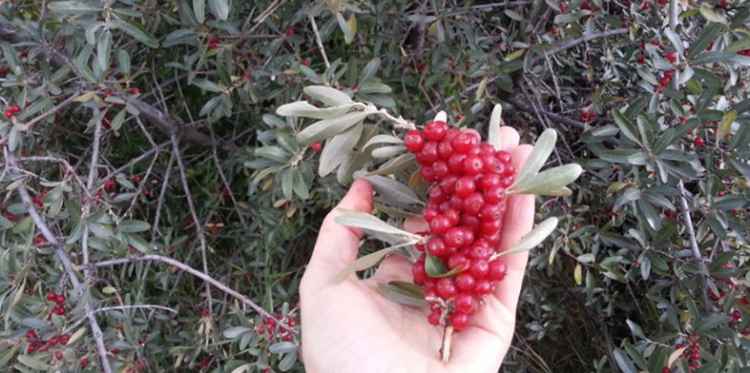

Ripens in September. For harvesting, berries can be frozen or dried in a well-ventilated area. Shepherdia is a beautiful shrub that will adorn any garden plot, it will help maintain vigor and good health. Unfortunately, this plant has not yet become as widespread as, for example, sea buckthorn.
We are sure that the readers who are engaged in the cultivation of the shepherd know that it can be both beneficial and harmful to health, and have their own ways of using it. And we hope that you will share with us the secrets of increasing health with the help of Canadian sea buckthorn. Write about it in the comments, your advice will be very valuable.
Landing rules
Shepherdia tree does not require special growing conditions. Its branched root system allows it to grow in rocky and steep areas.
Recommended timing
The best time to plant is spring. This is especially true in the Urals and Siberia. In the spring, Shepherdia is planted in April, when the soil thaws, but the buds have not yet woken up.
Choosing the right place
Shepherdia bushes are planted in full sun. She needs space. Low swampy places where fog and stagnant groundwater are possible are not suitable.
Soil preparation
Sandy and loamy soils will be good. They are quite nutritious and loose. Shepherdia herself can improve the soil on which it grows. The bacteria balls located on the roots provide the soil with nitrogen.
Important! Heavy soils are not suitable for growing it.
Selection and preparation of seedlings
For planting, seedlings with a developed root system are used. Cut dry and diseased roots. Healthy ones are pruned by 3 cm without touching the nodules. The branches are shortened by 1/3. The seedlings are placed in a solution of "Epin", "Heteroauxin" or potassium permanganate.
Algorithm and scheme of landing
Planting and caring for Shepherdia is nothing special. The first step is to prepare a planting pit 50 x 50 x 50 cm. A hill of fertile soil is poured into the middle. A seedling is placed on it, the roots are straightened.
Sprinkle the seedling with earth, while it is easily shaken to compact the soil. Planting is watered and mulched. 1.5-2 m are left between the seedlings. If you plan to make a hedge, half a meter is enough.
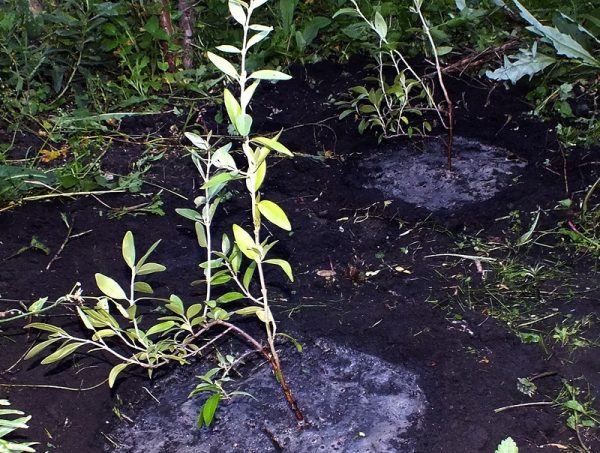

Fertilizer for Shepherdia
When planting, soil depleted in organic compounds is recommended to be fertilized with two or three buckets of humus or compost. Of course, the bottom of the pit in this case should be deeper, and this should be taken care of in advance.
No more feeding is needed for the chefedria. Moreover, it independently provides itself with nitrogen, being in symbiotic bonds with nitrogen-fixing unicellular organisms (by analogy with legumes).


Shepherdia: features of growing foreign sea buckthorn
Everyone has long known that sea buckthorn has incredibly useful properties. For several centuries it has been cultivated specifically for the manufacture of various medicinal sea buckthorn oils, tinctures, and everyone can tell about the extraordinary taste of tea made from this berry. In addition, the bushes of the plant have a pretty neat look and can become a good decoration of the estate. Not so long ago, a very close relative of sea buckthorn, shepherdia, was brought from North America.The plant, nicknamed the red sea buckthorn, is in no way inferior in the benefits of the usual sea buckthorn we are used to, but it looks even more charming and is well suited for use in landscape design.
Recipes for food and drinks with red sea buckthorn


A pleasant sour taste with a piquant bitterness, a wonderful aroma and a beautiful red color - thanks to all this, buffalo berries are in great demand in cooking. They can be eaten fresh and dried, frozen, prepared wines and liqueurs, compotes, mousses, preserves, jams and marmalades. The bitterness makes the fruit a component for sauces and marinades. And, of course, they make an excellent filling for pies. In addition, the berries are pickled for the winter.
Recipes with Shepherdia Silvery delicious food and drinks:
- Red sea buckthorn jam
... We wash the berries. We fill them with sugar in the proportion of 1 kg of fruit and 700 g of sugar. We stand for several hours so that they let the juice out. Put on the stove, bring to a boil and cook over low heat, stirring occasionally, for 5 minutes. We put the finished product in sterilized jars, cork, wrap until it cools. Enjoy your tea in winter!
Jam without heat treatment
... We wash 1.5 kg of berries, dry them and pass them through a meat grinder. Add 3 kg of sugar, mix well and put in sterilized jars. You can seal them or close them with nylon caps for preservation.
Red sea buckthorn jam
... We wash 1 kg of berries, grind them with a blender. Add 1.2 kg of sugar, pour in 1.2 liters of water and cook over low heat, stirring constantly. At the end of cooking, add 1-1.5 tbsp. lemon juice. We spread the jam in sterilized jars, and then, as usual, clogging, wrapping.
Read also: Wild strawberry jam "Pyatiminutka" for the winter: recipes, cooking features
Silver shepherdia compote
... We wash the red sea buckthorn berries, put them in a sterilized 3-liter jar (300 g). Prepare the syrup: boil 2 liters of water, add 0.5 kg of sugar, bring to a boil and pour in the fruits. We roll up the container. We wrap it up. This compote can be stored for 2 years.
Buffalo berry drink
... It will perfectly quench your thirst on hot summer days, and will also act as a diuretic on the body. Let's wash 0.5 kg of berries. We fill them with 2 liters of water. Bring it to a boil. Add 300 g of sugar. Drink to your health. It will be better than any store-bought sweet drink.
Biscuit
... We wash 300 g of silver shepherdia berries and pass them through a meat grinder. Add 400 g of flour, 0.5 g of powdered sugar, 3 eggs, 1 teaspoon of soda and a little salt to the berry mass. If desired, for a more lush dough, it is recommended to pour 2 tablespoons of starch into it. You need to bake the biscuit at a temperature of 180-200 degrees, for about 45 minutes.
Shanki with red sea buckthorn
... The first step is to make yeast pancakes or tortillas. To spread on our shanks, wash the fruits of the red sea buckthorn, pass them through a meat grinder, add sugar and starch, mix all these components well and spread on pancakes, and in the oven for 30 minutes. A product with an unusual name is ready.
Silver Shepherdia sauce
... We wash 200 g of berries and pass them through a meat grinder. We spread this mass in a saucepan, add salt, sugar and pepper to taste. Mix 2 tablespoons of flour in a small amount of water (this will add thickness to the sauce) and add to the ingredients. Cook over low heat, stirring occasionally. The result is a semi-liquid mass - the sauce is ready! You can add a little butter. It goes well with meat, pasta or mashed potatoes.
Red sea buckthorn sauce with spices
... Take 10 g of dry ginger, 5 g of turmeric, 10 g of ground red pepper and salt, 5 g of dry thyme and 10 g of dry tarragon. They were spices. We need 1 kg of berries, and 400 ml of water. From this amount of products, we get 300 g of sauce. First of all, we wash the sea buckthorn, fill it with water and boil it for 5 minutes.Then we make mashed potatoes from it with the help of a crush and cook for another 5 minutes. Then we cool the mass, pass it through a sieve and put it on fire again for 10 minutes. Add spices, cook for another 10 minutes and put in jars. The sauce is ready! An excellent addition to meat.
Shepherdia silvery tincture
... We wash 500 g of ripe berries and dry them. We crush the fruits with wooden pushers and put them in a jar. Add 150 g of liquid honey or 75 g of sugar. Pour 0.5 liters of vodka. Close with a tight lid, shake everything well and insist for 30 days in a dark, warm place. After a month, we filter the liquid and pour it into bottles.
Vitamin salad
... First, wash, peel and rub finely 400 g of carrots. Then grind with a blender half a glass of red sea buckthorn berries and cranberries, add 0.5 kg of sugar. Mix all components and fill with vegetable oil. This is a delicious and healthy salad.
... We wash 2 carrots, peel and grate. We pass 2 cloves of garlic through the garlic. Grind 0.5 cups of berries with a meat grinder or blender. We mix the components. Salt and add sugar to taste. We fill with 150 g of sour cream. This salad will boost your immune system and may be beneficial in fighting colds.
Shepherdia silvery: the benefits and harms of the plant
In the recipes of traditional medicine, shepherdia silvery is mentioned, the berries of which are used fresh and dried, as well as in the form of tinctures.
- The plant especially helps in the fight against colds and viral infections.
- An excellent effect is noted when using the plant to maintain the normal functioning of all organs of the body, the use of berries has a strong positive effect on the state of the digestive and cardiovascular systems.
- Tincture of Shepherdia berries on alcohol helps to reduce capillary fragility and cleanse the walls of blood vessels from cholesterol plaques. The tincture can be used to prevent atherosclerosis.
Shepherdia fruits are used in winemaking for making liqueurs, and they are also used to prepare jelly, mousse, and pastille.
Advice! The plant belongs to food and is not poisonous, however, people who are prone to allergies should be careful to eat shepherdia berries.
Landing and suitable climatic conditions
Shepherdia tolerates cold well, so it can be grown in the northern regions of the country, in the Urals, in Siberia. She will perfectly take root in the Moscow region.
If the climate is not arid, red sea buckthorn does not need special watering: a few rains during the summer will be enough.
The main advantages of this plant include:
- frost resistance;
- unpretentiousness;
- beneficial features;
- immunity to disease.
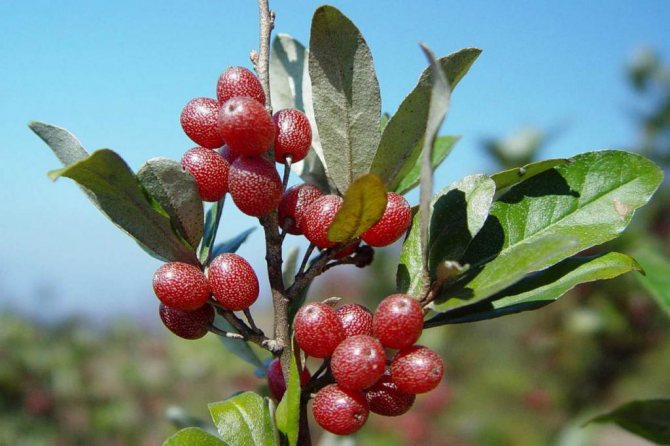

1
A bright and dry area, plenty of sunshine and protection from the winds are all you need to get a good harvest. Waterlogging has a destructive effect on shepherdia, planting on clay soils is contraindicated.
The diameter and depth of the planting pit should be about 60 cm. A few days before planting, it must be filled with a soil mixture consisting of earth, humus and wood ash, and covered with polyethylene on top.
The seedling is carefully placed in the hole, the roots are spread and the earth is poured to the top, and then lightly tamped. The plant, as mentioned above, does not tolerate excessive moisture, therefore, when watering, the main thing is not to overdo it. A distance of at least two meters must be left between the seedlings.
In order for the harvest to be successful, the soil must be regularly loosened and weeded, removing weeds.
Characteristic
Shepherdia Silvery is a deciduous plant. Its growth area is wide enough. This is due to its winter hardiness. Other American varieties of these berries are less popular in Russia.Shepherdia Canadian bears fruit with unsuitable berries for food, and Round-leaved has low frost resistance.
Main advantages
Shepherdia Silver has taken root well in the European climate. This is a frost-resistant plant, drought is not terrible for him. It is not affected by diseases and pests. Unpretentious, requires a minimum of maintenance. Quietly neighbors with various plants.
Flowering period and ripening time
Shepherdia Silvery blooms in April before the leaves appear. Clusters of small flowers stay on the branches for no more than 10 days. The berries reach maturity by the end of August. If left on the bush until frost, they will become sweeter.
Yield indicators, fruiting dates
With proper care, the plant will yield a bountiful harvest. A young bush 2 years after planting will give 15 kg of berries. Fruiting every year up to 30-50 years. The yield increases every year and can reach 30 kg per tree.
Scope of berries
In fresh form, it is almost never used because of the astringent tart aftertaste. Cooked desserts, sweet preparations in the form of jam or compote, low-alcohol drinks are popular. Shepherdia's benefits are invaluable. It is added to sauces for meat and fish dishes.
Properties of red sea buckthorn
Due to its extensive composition of trace elements and vitamins, shepherdia fruits are included in the diet menu, used in pharmacology, including as a component of herbal preparations, as well as in cooking.


Useful and medicinal properties
The shrub is an excellent honey plant and a unique medicinal plant. For medicinal purposes, not only Shepherdia berries are used, but also its leaves, inflorescences, bark and resin.
Berries are rich in lycopene, which helps reduce the risk of cancer, heart disease, and asthma. Lycopene is an antioxidant that destroys free radicals and performs vital functions in the human body:
- Activation of the digestion process;
- Fight against pathogenic intestinal microflora;
- Normalization of cholesterol metabolism;
- Obstacle to the development of atherosclerosis by strengthening blood vessels;
- Nourishes and regenerates the skin;
Important! The level of lycopene in the blood decreases with aging, alcohol consumption and smoking.
Red sea buckthorn has a beneficial effect on the walls of blood vessels, reducing their fragility and increasing elasticity, thus. protecting the vessels from sclerotic lesions. The consumption of fruits supports the efficiency of the entire cardiovascular system.
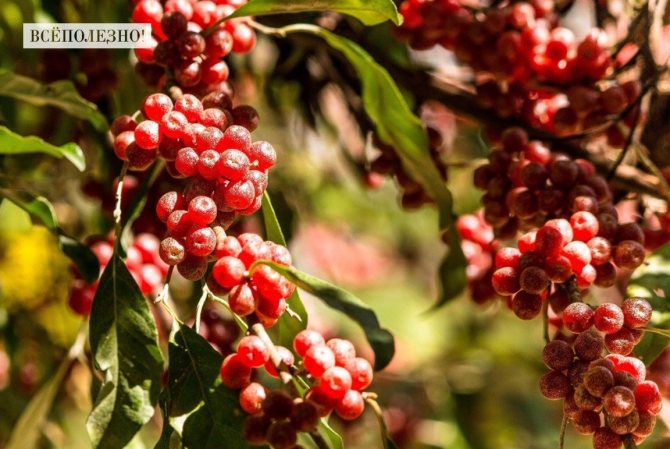

Vitamin PP, which is found in fruits, is responsible for redox reactions in the body. It regulates higher nervous activity, prevents the development of thrombosis and hypertension. Vitamin PP affects the production of hormones such as testosterone, progesterone, cortisol and insulin.
Important! Nausea, poor appetite, gum disease, and bad breath can be signs of a vitamin PP deficiency.
The fruits are included in the diet menu in the treatment of diseases of the gastrointestinal tract. Vitamins of group B, which are contained in berries, normalize the processes of digestion and absorption of food in the small intestine. In the complex treatment of diseases associated with the gastrointestinal tract, shepherdia silver berries help to reduce inflammation.
For women and during pregnancy
Shepherdia silvery is one of the best berries for strengthening women's health, having a positive effect on all organs and functions of the body:
- Fruits strengthen the immune system and increase the body's resistance to viruses: due to the increased content of vitamin C, the amount of which is hundreds of times more than in citrus fruits, as well as phytoncides - natural antibiotics.
- Phenolic compounds help in the normalization of intestinal microflora. The fruits are also used for gastritis and pancreatitis, since they have an enveloping, wound healing and regenerating effect.
- Often women suffer from kidney disease.Therefore, shepherdia silver can be used for preventive purposes in order to avoid urolithiasis. The fruits, when added to tea, have a diuretic effect and promote the elimination of stones.
- In case of nervous breakdowns and stresses, preparations containing vitamin B are prescribed. Shepherdia silvery is not a drug, but for the prevention of nervous disorders, and in combination with other drugs, it has a positive effect on the functioning of the nervous system. In addition, these fruits contribute to the production of the hormone endorphin - the hormone of joy and love.
- Due to the high content of vitamin E in berries, the aging process of the skin and organs slows down. Moreover, vitamin E affects the fertilization of the egg and the synthesis of sex hormones in the required amount.
Organic acids, which are contained in fruits, prevent skeletal muscle atrophy during aging of the body, contribute to weight loss and blood sugar levels. With their participation, the disposal of cholesterol, radionuclides and ballast products occurs.
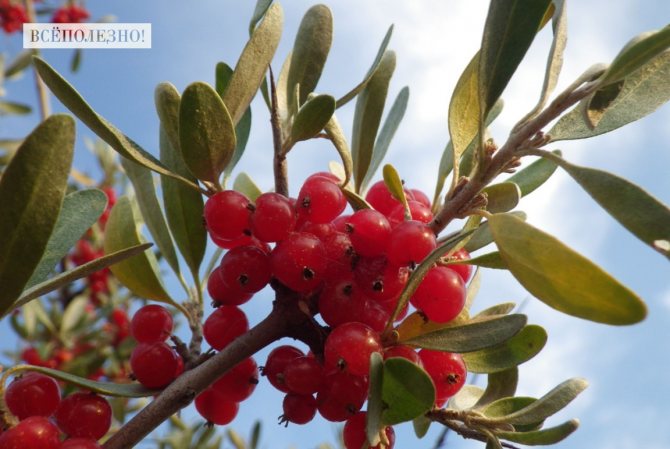

Berries are not contraindicated for pregnant women, but they can cause allergic reactions, so it is better to consult an obstetrician-gynecologist.
For men
Shepherdia silvery is not a drug, it is used in pharmacology as an additional component that enhances the effect of basic substances.
- Zinc and selenium, which is present in berries, protects liver cells from toxic effects on it.
- Vitamin A, which is found in excess in fruits, prevents vision loss and skin aging.
- It is used as an additional remedy, due to the high content of B vitamins, in case of potency disorders.
- Reduces the risk of stomach, lung and prostate cancer due to the content of the antioxidant lycopene.
- The leaves and bark of the plant are used to treat constipation, tuberculosis, inflammation, cuts, arthritis, and even sexually transmitted diseases.
- In North America, a strong decoction of the roots was used to treat syphilis, it was poisonous enough, so men became infertile.
- The juice of berries is used to treat acne and relieve inflammation of boils.
- Reduces blood pressure and prevents the occurrence of heart attack and stroke.
For kids
Many parents, having heard about berries with an abundant content of vitamins and minerals, begin to feed their children. Biologically active substances that are contained in silver shepherdia can harm a young body. You should refrain from eating fruits by children.
Harm and possible contraindications
Despite the fact that shepherdia silvery is called "superfruit", its fruits and products, in which it is included, must be treated with caution when:
- Liver disease;
- Acute stage of gallbladder disease;
- An aggravated form of kidney disease;
- Manifestation of allergic reactions.
Where to buy seedlings?
And in conclusion: readers often ask about where to get seeds, cuttings or seedlings in order to start growing this or that new plant for your site. The question is a bit strange, albeit an interesting one: you are on the Internet! And it is interesting because now is the time to take care of the seeds, and the cuttings, and the seedlings. And this time is limited, perhaps, by the end of April. It seems that the most productive speech is still to talk about seedlings, because it is the seedlings that will allow you to master this or that culture in the shortest possible time, including the shepherd.
I consider it my duty to make a few comments. First, find an online store nevertheless closer to your home or site: for example, a store in Moscow is suitable for some, and in Tomsk for others. Secondly, pay attention to the prices, because their range is very wide - from 300 rubles to 1500 rubles - for seedlings.So, "think for yourself, decide for yourself" where to buy the plants you like. And the most suitable time to make your choice is March and April. Success to you, my friends, dare.
And from me, in the end, a little advice, if you will allow: so that your seedlings grow faster, do not forget to feed them in spring with nitrogen fertilizers, preferably in a form dissolved in water. In this way, I very quickly grew a whole plantation of berries from cuttings and for many years I have been very fond of their harvests, and even more pleasant is the wine that I like to treat my friends with.
Description of fruits and shrubs
For growing in gardens in the Russian open spaces, only Shepherdia silver is suitable. It bears fruit every year - up to 15 kg of berries are harvested from one bush. Landscape designers love to use it in their compositions.
Due to the strongly curved, intertwined with each other, especially near the ground, shoots, forming impassable thickets, and sharp numerous thorns - the culture is ideal for the formation of hedges.
Flowering begins as soon as the air warms up to 7-9 ° C heat. First, yellow, creamy tiny flowers, collected in a brush, bloom, then the shrub is covered with leaves. Flowers last up to 1.5 weeks and attract a large number of insects to the site.
By the end of summer, berries are formed. They are spherical, red-orange or scarlet, small in size - 5-6 mm in diameter. Characteristic white spots are sprinkled over the entire surface of the berries. Collecting them is recommended after the first frost.
Healing properties of shepherdia silver
Shepherdia silvery grows naturally in Canada and North America. The plant is a shrub with red berries, belongs to the Lokhovye family, a close relative of sea buckthorn. The plant has males and females, therefore, to get berries, it is necessary to plant both varieties of the plant side by side.
The Indians have long known the value of red berries, they used the fruits of Shepherdia for food, they were treated for many diseases. Freshly picked Shepherdia berries taste quite sour, with a pronounced bitterness. If they are exposed to frost, the taste becomes softer.
Soil for Shepherdia
For planting, in principle, any soil is suitable, since fruiting can be abundant on both sandy and clayey. It is possible to improve the conditions for the development of a young shepherdia by regularly loosening the near-stem soil to a depth of about 6 cm (no more, because the root system is of a surface type) and removing weeds from there.
A mulching layer 5 cm thick will also not interfere.It is important that when shoots appear from the roots, immediately use them as planting material, or simply uproot them, doing this carefully, digging the ground up to the junction of the appendix with a horizontal root and cutting off the first pruner under the base, so as not to hemp remained. The resulting pits are backfilled with earth.
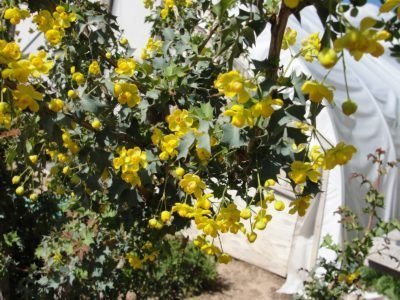

Cooking tips
To prepare blanks from berries, you should put them on an open fire or stove. After the liquid has boiled, it is necessary to pass them through a sieve. Sweeten to taste. Pure, undiluted Shepherdia juice is very strong and bitter in taste, so it is recommended to dilute it with water, milk, yogurt, carrot or pumpkin juice.
The easiest way to store buffalo berries is to freeze them. Shepherdia fruits should be absolutely healthy, and the harvested berries after freezing should either be eaten immediately or placed in the freezer. In the freezer, sea buckthorn fruits can be stored whole or crushed, with or without sugar..
Names
Perhaps no plant has as many names as shepherdia. In America it is called "bison" or "buffalo berry" and also "rabbit berry". It is believed that these nicknames came from the fact that locals traditionally prepare berry gravy, serving it with bison (and rabbit) meat.According to another version, wild artiodactyls enjoy eating Shepherdia fruits, just like our bears do.
Another interesting name is “soap berry”. The fruits acquired it because of the slippery sensation that appears on the skin when rolled in the palms of the hands. Hands become, as it were, slightly soapy. The fruits are also called "currants from Nebraska", "American sea buckthorn", "silver leaf". A rather unusual name - "crucified berry" - shepherdia received for the structure of the leaves, which are located crosswise.
Formation and thinning of the crown
The culture grows quickly and branches well. It is better to limit the height of the plant - this will make it easier to harvest and care for the shrub. It is enough to leave 2-2.5 m in height, shortening the side shoots to the first branches. This operation is performed once every 3-5 years.
With age, the growth of the bush slows down. Shepherdia, 7-8, needs anti-aging pruning. All shoots of this age are cut, the rest are shortened for the growth of the last 2-3 years. This radical pruning stimulates the plant to branch out and form larger berries.
Sanitary pruning is carried out annually in spring and autumn - cutting out broken, dried or thickening shoots.
Application features
Red sea buckthorn berries are used orally raw, dried, in syrup or tincture. In the USA and Canada, shepherdia silver is grown commercially and used in cosmetology for the manufacture of creams, shampoos, scrubs, and nail care products.
Fact! Due to the high content of vitamin A, this plant is used in the production of shampoo: to treat dandruff, strengthen hair follicles and improve the condition of the skin.
In addition to useful nutritional and medicinal properties, the fruits have an unusual bitter-sour tart taste and therefore are used in cooking.
Important! Excessive consumption of Shepherdia silver berries leads to bloating and diarrhea, and sometimes to death.
The shrub is used in landscaping:
- as a decoration, thanks to bright fruits;
- as a fence to protect from strong winds;
- strengthening the soil on the slopes, because has a powerful root system.
In folk medicine for the treatment of diseases
In folk medicine, tea or shepherdia fruit syrup is widely used as a fortifying, immunostimulating and anti-inflammatory agent. The oil obtained from the seeds is used to treat skin diseases and local inflammation.
Syrup preparation:
- The berries are thoroughly washed.
- Dry within 10-15 minutes.
- After that, the fruits are crushed with a blender.
- The resulting mass is wiped through a sieve.
- The resulting juice is poured into a ladle and placed on the stove over low heat.
- Sugar is added in a 1: 1 ratio.
- The juice is not brought to a boil, but only heated to dissolve the sugar.
- Syrup is poured into a sterile jar and sealed.
- After cooling, the syrup is stored in the refrigerator.
In cooking
Shepherdia berries are edible: they can be eaten both fresh and dried. They taste tart, but they become sweeter after the first frost. Native Americans know thousands of ways to prepare these berries. For example, the popular canned food made from dried buffalo meat and berries. Now jams and sauces are traditionally made from them.
Sweet and sour sauce of shepherdia silver for baked vegetables or meat
Ingredients:
- Shepherdia - 1 kg;
- Water - 400 ml;
- Salt - 10 g;
- Turmeric - 5 g;
- Ground red pepper - 10 g;
- Dry thyme - 5 g.
- Peeled berries are thoroughly washed, poured with the required amount of water and boiled for 5 minutes.
- After that, the boiled berries are crushed with a blender until puree is formed.
- The puree is rubbed through a sieve to get rid of the seeds and remnants of the peel.
- After that, the peeled, homogeneous fruit puree is boiled for 5 minutes.
- Add spices and boil for another 10-15 minutes, until excess moisture is gone.
- The hot prepared sauce is poured into sterile jars and rolled up.
In addition to syrup and sauce, jelly is prepared from shepherdia, jam, inflorescences and leaves are added to tea. Compote is made from berries and used in baking.
How and when to pick and store berries
It is best to pick berries after the first frost. Then it will be easiest to remove the sea buckthorn from the branches, and it will have an optimal level of maturity. This will allow you to easily prepare compotes and jam from it, provided that the useful properties of the product are preserved.
Important! Red sea buckthorn contains tetrahydroharmol: in a sufficiently large volume, it acts on the human body as a psychedelic.
The easiest way to harvest the fruits of a sea buckthorn / barberry hybrid is to lay a sheet around the bush and just shake the branches a little. The berries crumble easily, which will allow you not to use special means for harvesting. To preserve the berry for the winter, you can dry it.


Further, it will be possible to cook compote from it or use it for other culinary purposes. Shepherdia is often prepared immediately, processed into jam or making a sauce.
Types of Shepherdia
Shepherdia silver (Shepherdia argentea) is grown for tasty, healthy berries and is used for decorative purposes.
Canadian Shepherdia (Shepherdia canadensis) is a beautiful spreading shrub up to 1.5 m in height. The leaves are colored silvery on one side, and gray-green on top, there are no thorns on the branches. Due to its low frost resistance, it is little used by designers, although it has a bright color.
Did you know? The scientific name for sea buckthorn is Hippophae ("hippos" - horse, "faos" - brilliant). The etymology of the word has its origins in Ancient Greece, where horses were treated with the leaves of this tree.
Round-leaved shepherdia (Shepherdia rotundifolia) - taller than its relatives, but at the same time retains its spreading shape. The crown is dense, the branches are intertwined with rounded dark green leaves.
A distinctive feature is the unique warty covering of the leaves with small growths. Abundant flowering leads to a rich harvest of beautiful but inedible berries. Round-leaved shepherdia in local gardens feels comfortable and is used as a decorative element.
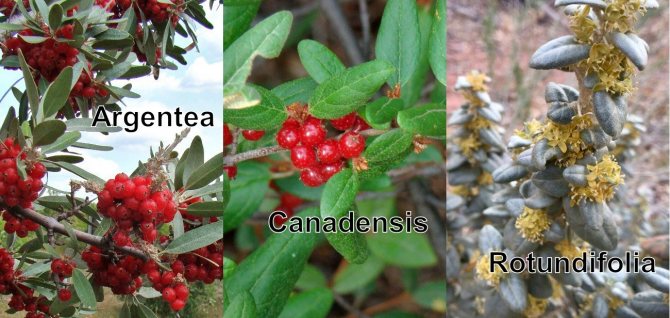

Varieties
In total, there are three types of plants in this class. Their names:
- Silver - Argentea
- Canadian - Canadensis
- Round-leaved - Rotundifolia
They vary in leaf shape, fruit size and color. In order to obtain a harvest, the first type of shrub is cultivated. The last two are considered more decorative.
Argentea
This variety is more similar to our sea buckthorn. He has the same narrow and long leaves, densely sprinkling the branches of the tree. The surface of the leaf on both sides is covered with many villi, which makes them appear silvery. Berries up to 6 mm in diameter. The ripe fruit turns scarlet, orange-red shades prevail. This species includes the Golden Eye variety bred by breeders, the berries on it are juicy yellow, which appear golden in the sun.
Canadensis
The Canadian type of shepherdia is mainly used to decorate adjoining territories. His berries are small, with unexpressed taste. Fruit size - from 4 mm, oblong shape. The leaves are dark green, with a gray tint, oval. The edge is predominantly on the lower side. This variety does not form thorns. The height of the trunk is small - the trees are stretched only up to 2-2.5 m.
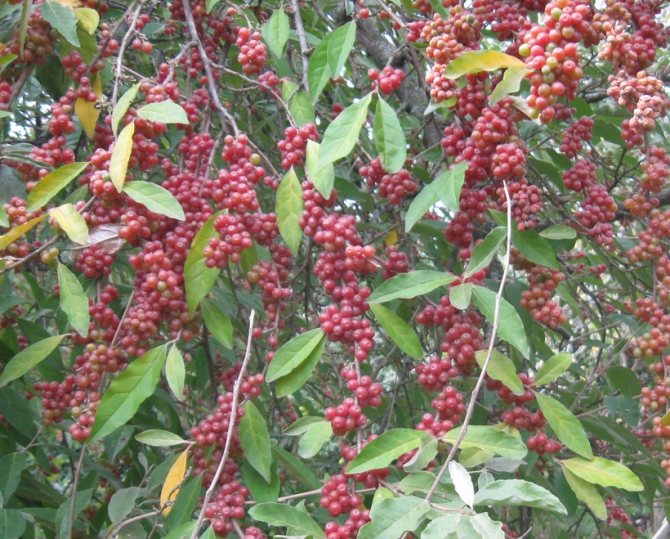

Rotundifolia
Round-leaved shepherdia is a tall shrub with a spreading crown. The branches diverging to the sides are strongly twisted and intertwined. The peculiarity of this variety is rounded thick leaves with an edge, speckled with growths. The trees give abundant color and many fruits. Under the weight of foliage and berries, the crown often bends to the very bottom, which is a beautiful sight. Silver-olive foliage, with clusters of scarlet berries, cascades down from the top of the crown to the ground.
Pruning shepherdia
Finally, the most important aspect of chefedria care is pruning. The removal of old broken branches should be carried out annually, along with this, if necessary, maintaining the normal shape of the tree / bush.
The main part of the procedure is to thin out the branches that compact the crown - everything that is frozen, broken and located asymmetrically must be pruned. To this, in trees that yield a crop, there is a periodic decrease in the crown, suggesting the shortening of the branches leading in height to the lateral branches.
Reducing the crown at a height of 2-2.5 meters can significantly facilitate both plant care and berry picking. Together with the attenuation of the growth of axial and lateral branches during aging, it is recommended to rejuvenate them by shortening them by two to three years of wood for every 7th year of life. If the crown is drooping, only stems and branches that grow vertically should be left when pruning. The described measures will not only strengthen the health of the tree, but also contribute to the enlargement of berries, the abundance of fruiting.


Advantages and disadvantages of Shepherdia
If you have not yet decided whether or not to plant this crop on your site, then the advantages and disadvantages will help you decide.
The pluses of Shepherdia include:
- unpretentiousness;
- high winter hardiness;
- immunity to various diseases and pests;
- ease of reproduction.
There are also disadvantages to culture:
- dioecious plant;
- thorny branches.
Possible problems and solutions
In the case of Shepherdia, no special problems that hinder development and fruiting have been identified. The plant is unpretentious, with suitable climatic conditions and sufficient sunlight, it can give a bountiful harvest.
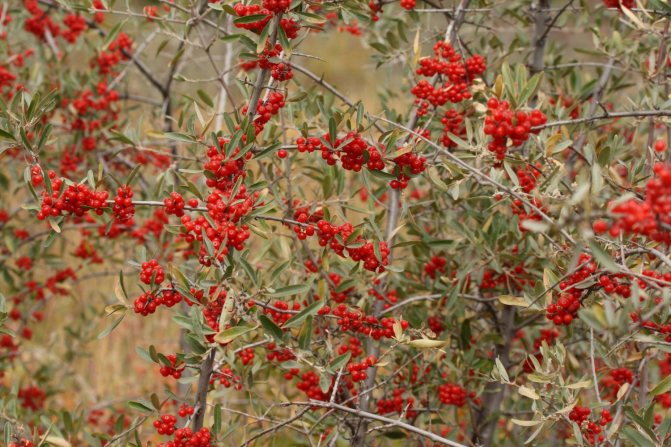

1
It is not recommended to water the shrub too often, this will help to avoid rotting of the root system. Top dressing also needs to be taken seriously: excess nitrogen delays the time of flowering and harvesting, if you overdo it with magnesium, this can lead to leaf curling, excess potassium will slow down the growth of red sea buckthorn. If oversaturation does occur, it can be corrected by irrigation (12-15 liters per 1 square meter). This method will remove active substances from the upper layer.
It's good if the shepherdia is protected by some kind of barrier from gusts of cold wind. But this requirement is not strict.

